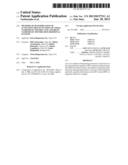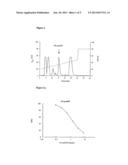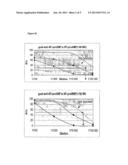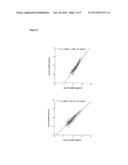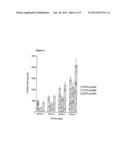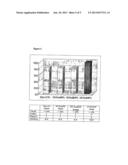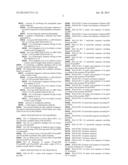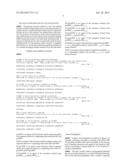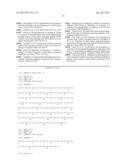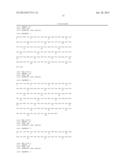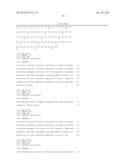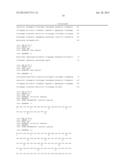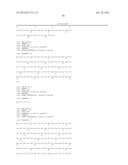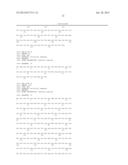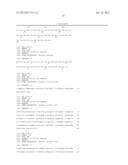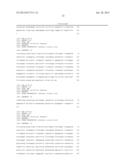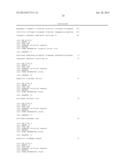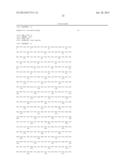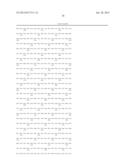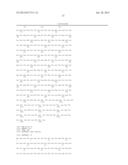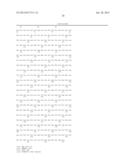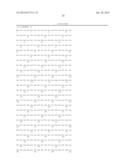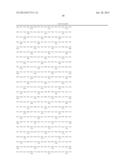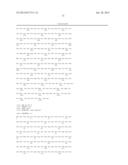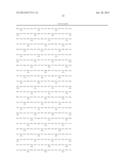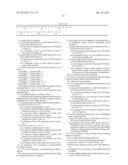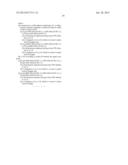Patent application title: Methods of Determination of Activation or inactivation of Atrial Natriuretic Peptide (ANP) and Brain Natriuretic Peptide (BNP) Hormonal Systems
Inventors:
Orion Diagnostica Oy (Espoo, FI)
Olli Vuolteenaho (Oulu, FI)
Minna Ala-Kopsala (Oulu, FI)
Heikki Ruskoaho (Tyrnava, FI)
Juhani Leppäluoto (Oulu, FI)
Jouko Haapalahti (Kempele, FI)
Assignees:
ORION DIAGNOSTICA OY
IPC8 Class: AG01N3374FI
USPC Class:
435 694
Class name: Micro-organism, tissue cell culture or enzyme using process to synthesize a desired chemical compound or composition recombinant dna technique included in method of making a protein or polypeptide hormones and fragments thereof
Publication date: 2013-06-20
Patent application number: 20130157311
Abstract:
An in vivo method of determining activation or inactivation of the atrial
natriuretic peptide (ANP) and brain natriuretic peptide (BNP) hormonal
systems, the method comprising simultaneously detecting the presence or
amount of atrial and brain natriuretic peptide prohormones (proANP and
proBNP) or fragments thereof in a sample.Claims:
1. An agent which comprises: (a) (i) proANP (SEQ ID NO:1), ANP (SEQ ID
NO:2), or NT-proANP (SEQ ID NO:3); (ii) a homologous sequence having at
least 70% identity to (a)(i); or (iii) a fragment of (a)(i) or (a)(ii)
which is at least 6 amino acids in length; and (b) (i) pro-BNP (SEQ ID
NO:4), BNP (SEQ ID NO:5), or NT-proBNP (SEQ ID NO:6); (ii) a homologous
sequence having at least 70% identity to (b)(i); or (iii) a fragment of
(b)(i) or (b)(ii) which is at least 6 amino acids in length.
2. An agent according to claim 1 which comprises or consists of: (a) proBNP15-24 and proANP82-96; (b) proBNP1-37 and proANP29-98; (c) proBNP10-29 and proANP20-80; (d) proBNP1-76 and proANP1-98; (e) proBNP10-29 and proANP60-80; (f) proBNP1-108 and proANP1-126; or (g) proBNP77-92 and proANP.sub.112-126.
3. An agent according to claim 2 which comprises any one of SEQ ID NOs:13, 14, 15, 17, 18, 19, or 20.
4. An agent according to claim 1 which is labelled with a detectable label.
5. A polypeptide agent according to claim 1.
6. A polynucleotide comprising sequence which encodes a polypeptide agent according to claim 5 or sequence which is complementary to said coding sequence.
7. A polynucleotide according to claim 6 which comprises: (a) (i) SEQ ID NOs:7, 8, or 9; (ii) a sequence complementary to (a)(i); (iii) a sequence which hybridizes under medium or high stringent conditions to (a)(i) or (a)(ii); (iv) a sequence which is degenerate as a result of the genetic code to (a)(i), (a)(ii), or (a)(iii); (v) a sequence having at least 70% identity to any of the sequences in (a)(i) to (a)(iv); or (vi) a fragment of any of the sequences in (a)(i) to (a)(v); and (b) (i) SEQ ID NOs:10, 11, or 12; (ii) a sequence complementary to (b)(i); (iii) a sequence which hybridizes under medium or high stringent conditions to (b)(i) or (b)(ii); (iv) a sequence which is degenerate as a result of the genetic code to (b)(i), (b)(ii), or (b)(iii); (v) a sequence having at least 70% identity to any of the sequences in (b)(i) to (b)(iv); or (vi) a fragment of any of the sequences in (b)(i) to (b)(v).
8. An expression vector comprising a polynucleotide according to claim 6.
9. A host cell comprising a polynucleotide according to claim 6.
10. A process for producing a polypeptide agent according to claim 5 which process comprises: (I) cultivating a host cell comprising a polynucleotide, or its complement, which encodes a polypeptide which comprises: (a) (i) proANP (SEQ ID NO:1), ANP (SEQ ID NO:2), or NT-proANP (SEQ ID NO:3); (ii) a homologous sequence having at least 70% identity to (a)(i); or (iii) a fragment of (a)(i) or (a)(ii) which is at least 6 amino acids in length; and (b) (i) pro-BNP (SEQ ID NO:4), BNP (SEQ ID NO:5), or NT-proBNP (SEQ ID NO:6); (ii) a homologous sequence having at least 70% identity to (b)(i); or (iii) a fragment of (b)(i) or (b)(ii) which is at least 6 amino acids in length. under conditions to provide for expression of the polypeptide; and optionally (II) recovering the expressed polypeptide.
11. A process for producing a polypeptide agent according to claim 5 which comprises chemical synthesis.
12. A diagnostic kit comprising: (a) a bi or oligo specific first binding substance that is able to bind to both (I) (i) proANP (SEQ ID NO: 1), ANP (SEQ ID NO: 2), or NT-proANP (SEQ ID NO: 3); (ii) a homologous sequence having at least 70% identity to (i); or (iii) a fragment of (i) or (ii) which is at least 6 amino acids in length; and (II) (i) proBNP (SEQ ID NO: 4), BNP (SEQ ID NO: 5), or NT-proBNP (SEQ ID NO: 6); (ii) a homologous sequence having at least 70% identity to (i); or (iii) a fragment of (i) or (ii) which is at least 6 amino acids in length; or (b) said first binding substance and a fusion polypeptide agent comprising both: (I) proANP (SEQ ID NO:1), ANP (SEQ ID NO:2), or NT-proANP (SEQ ID NO:3); and (II) proBNP (SEQ ID NO:4), BNP (SEQ ID NO:5), or NT-proBNP (SEQ ID NO:6), wherein said fusion polypeptide agent can be bound by said first binding substance, and optionally the binding substance and/or the agent is labelled.
13. A kit according to claim 12 wherein the first binding substance comprises (a) bi- or oligo-specific binding substance; (b) a mixture of mono-specific binding substances; (c) natriuretic receptor GC-A (SEQ ID NO: 33); (d) homologous sequence having at least 70% identity to (c); (e) a fragment of (c) or (d) which is at least 400 amino acids in length; (f) an extracellular binding domain of the natriuretic receptor GC-A (SEQ ID NO: 34); and/or (g) is present on a solid support comprising a bi- or oligo-specific antibody, fragment or derivative thereof which is able to bind to both: (a) (i) proANP (SEQ ID NO: 1), ANP (SEQ ID NO: 2), or NT-proANP (SEQ ID NO: 3); (ii) a homologous sequence having at least 70% identity to (i); or (iii) a fragment of (i) or (ii) which is at least 6 amino acids in length; and (b) (i) proBNP (SEQ ID NO: 4), BNP (SEQ ID NO: 5), or NT-proBNP (SEQ ID NO: 6); (ii) a homologous sequence having at least 70% identity to (i); or (iii) a fragment of (i) or (ii) which is at least 6 amino acids in length.
14. A kit according to claim 12 wherein the agent comprises (a) (i) proANP (SEQ ID NO: 1), ANP (SEQ ID NO: 2), or NT-proANP (SEQ ID NO: 3); (ii) a homologous sequence having at least 70% identity to (i); or (iii) a fragment of (i) or (ii) which is at least 6 amino acids in length; and (b) (i) proBNP (SEQ ID NO: 4), BNP (SEQ ID NO: 5), or NT-proBNP (SEQ ID NO: 6); (ii) a homologous sequence having at least 70% identity to (i); or (iii) a fragment of (i) or (ii) which is at least 6 amino acids in length.
Description:
TECHNICAL FIELD OF THE INVENTION
[0001] The invention relates to test methods useful for the diagnosis and/or monitoring treatment of cardiac conditions such as heart failure and to substances for use in the methods.
BACKGROUND OF THE INVENTION
[0002] Congestive heart failure (CHF) is a clinical syndrome caused by heart disease, characterised by breathlessness and abnormal sodium and water retention, and resulting in oedema. This occurs when the heart is unable to generate a cardiac output sufficient to meet the demands of the body without marked increase of diastolic pressure. It is a consequence of a cardiac disease which impairs ventricular systolic or diastolic function, or both. It is not a single disease but the end stage of many different forms of heart diseases, the most common of which are the coronary artery diseases, hypertension and diabetes (Kannel et al. 1994). Heart failure is manifested by symptoms of poor tissue perfusion (e.g., fatigue, poor exercise tolerance) or congestion of vascular beds (e.g., dyspnoea, pulmonary oedema, peripheral oedema) or both. Treatment of heart failure is generally directed towards its underlying causes.
[0003] The prevalence of symptomatic heart failure in the general population in Europe is estimated to be about 0.4-2%. As the prevalence rises rapidly with age, the increasing life expectancy is expected to have a major impact on the incidence of heart failure in the near future. The asymptomatic form of left-ventricular systolic dysfunction is estimated to be as common as symptomatic congestive heart failure (McDonagh et al. 1997).
[0004] The current routine clinical and investigative parameters used for the diagnosis of heart failure (clinical examination, electrocardiography, chest X-ray) have been found to be inadequate because the diagnosis causes false-positive results (Remes et al. 1991). Echocardiography provides specific diagnostic and prognostic information, but it is not particularly suitable for screening or for rapid point-of-care diagnostics. Thus, there is a need for new diagnostic tests for cardiac impairment.
[0005] A number of studies have demonstrated the usefulness of measurement of single peptides derived from atrial natriuretic peptide prohormone (proANP) and brain natriuretic peptide prohormone (proBNP) in the diagnosis of heart failure (Talwar et al. 2000; De Lemos et al. 2001; Daly et al. 2002). Cardiac impairment is associated with elevated circulating levels of atrial natriuretic peptide (ANP), brain natriuretic peptide (BNP), N-terminal fragment of proANP (NT-proANP) and N-terminal fragment of proBNP (NT-proBNP) (Sagnella 1998). High plasma concentrations correlate with poor prognosis after myocardial infarction and heart failure (Omland et al. 2002). Moreover, monitoring plasma levels of NT-proBNP appears to offer more powerful guidance in therapy of heart failure than follow-up by conventional clinical parameters (Troughton et al. 2000).
[0006] However prior art diagnostic methods, such as those disclosed in WO 87/06938, WO 00/35951, WO 91/00292, U.S. Pat. No. 5,786,163, EP 648 228 B1, WO 00/45176, WO 00/19207, U.S. Pat. No. 6,124,430, EP 542 255 B1) or those commercially available, are only intended to measure, and are only capable of measuring, a single peptide (ANP, BNP, NT-proANP or NT-proBNP) at a time. For example, the prior art discloses the use of ANP receptor or NPRA (GC-A) receptor in assays to determine natriuretic peptides, but does not disclose any simultaneous determination of natriuretic peptides. U.S. Pat. No. 5,747,274 discloses simultaneous detection of at least three cardiac markers using at least three different monoclonal or polyclonal antibody pairs, each specific for a different marker. Consequently, these assays produce multiple results. Thus there remains in the art a need for a reliable and sensitive but relatively cheap and simple means for detecting or diagnosing cardiac impairment such as heart failure.
[0007] Accordingly the present invention provides a test method which detects activation or inactivation of the ANP and BNP hormonal systems by assaying for both proANP- and proBNP-derived peptides simultaneously. Both proANP and proBNP derived peptides may be assayed in the same sample, at the same time. The method produces a single result and is simpler to perform than prior art methods. Moreover the present assay methods show greater sensitivity than prior art methods. Further still, the present test has a profound capability to give a reliable test result whether the patient is in an early phase or late phase of heart failure. The single assay format of the present invention, performed simultaneously per se, offers a cheaper and more cost effective alternative to the available tests thus allowing reliable measurement of activation or inactivation of both the ANP and the BNP hormonal systems
SUMMARY OF THE INVENTION
[0008] Accordingly the present invention provides an in vitro method of determining activation or inactivation of the atrial natriuretic peptide (ANP) and brain natriuretic peptide (BNP) hormonal systems, the method comprising simultaneously detecting the presence or amount of atrial and brain natriuretic peptide prohormones (proANP and proBNP) or fragments thereof in a sample.
[0009] The invention also provides:
[0010] an agent which comprises:
[0011] (a) (i) proANP (SEQ ID NO. 1), ANP (SEQ ID NO. 2) or NT-proANP (SEQ ID NO. 3);
[0012] (ii) a homologous sequence having at least 70% identity to (i); or
[0013] (iii) a fragment of (i) or (ii) which is at least 6 amino acids in length; and
[0014] (b) (i) pro-BNP (SEQ ID NO. 4), BNP (SEQ ID NO. 5), NT-proBNP (SEQ ID NO. 6);
[0015] (ii) a homologous sequence having at least 70% identity to (i); or
[0016] (iii) a fragment of (i) or (ii) which is at least 6 amino acids in length;
[0017] a polynucleotide comprising sequence which encodes the agent, or complementary sequence:
[0018] an expression vector and host cell comprising the polynucleotide;
[0019] a process for producing the polypeptide agent which comprises:
[0020] (a) cultivating the host cell under conditions to provide for expression of the polypeptide; and optionally
[0021] (b) recovering the expressed polypeptide;
[0022] a method of identifying a substance that binds specifically to
[0023] (a) (i) proANP (SEQ ID NO. 1), ANP (SEQ ID NO. 2) or NT-proANP (SEQ ID NO. 3);
[0024] (ii) a homologous sequence having at least 70% identity to (i); or
[0025] (iii) a fragment of (i) or (ii) which is at least 6 amino acids in length and
[0026] (b) (i) pro-BNP (SEQ ID NO. 4), BNP (SEQ ID NO. 5), NT-proBNP (SEQ ID NO. 6);
[0027] (ii) a homologous sequence having at least 70% identity to (i); or
[0028] (iii) a fragment of (i) or (ii) which is at least 6 amino acids in length which method comprises:
[0029] (A) contacting a candidate substance with (a) and (b) under conditions which allow specific binding; and
[0030] (B) determining whether the candidate substance binds to (a) and (b);
[0031] an antibody, fragment or derivative thereof which is able to bind to both:
[0032] (a) (i) proANP (SEQ ID NO. 1), ANP (SEQ ID NO. 2) or NT-proANP (SEQ ID NO. 3);
[0033] (ii) a homologous sequence having at least 70% identity to (i); or
[0034] (iii) a fragment of (i) or (ii) which is at least 6 amino acids in length; and
[0035] (b) (i) pro-BNP (SEQ ID NO. 4), BNP (SEQ ID NO. 5) or NT-proBNP (SEQ ID NO. 6);
[0036] (ii) a homologous sequence having at least 70% identity to (i); or
[0037] (iii) a fragment of (i) or (ii) which is at least 6 amino acids in length
[0038] a process for making the antibody;
[0039] a solid support comprising the antibody.
[0040] The invention further provides methods of diagnosing and/or monitoring treatment of heart failure and a diagnostic kit for use in such methods.
BRIEF DESCRIPTION OF THE DRAWINGS
[0041] FIG. 1: Purification by reverse phase HPLC of a novel protein or peptide agent of the invention.
[0042] FIG. 2a: A competitive binding curve for immunoassay of NT-proXNP
[0043] FIG. 2b: Development of antibody titres in immunisation of a goat using a GST-fusion protein of NT-proXNP2 as immunogen.
[0044] FIG. 3: Serum levels of NT-proANP, NT-proBNP and NT-proXNP in patients with cardiac disorders.
[0045] FIG. 4: Serum levels of NT-proANP, NT-proBNP and NT-proXNP in cardiac patients.
[0046] FIG. 5: Response of plasma NT-proANP, NT-proBNP and NT-proXNP and cardiac output (CO) in patients of heart failure to therapy.
BRIEF DESCRIPTION OF THE SEQUENCES
[0047] SEQ ID NO: 1 amino acid sequence of human proANP
[0048] SEQ ID NO: 2 amino acid sequence of human ANP
[0049] SEQ ID NO: 3 amino acid sequence of human NT-proANP
[0050] SEQ ID NO: 4 amino acid sequence of human proBNP
[0051] SEQ ID NO: 5 amino acid sequence of human BNP
[0052] SEQ ID NO: 6 amino acid sequence of human NT-proBNP
[0053] SEQ ID NO: 7 nucleotide sequence encoding human proANP
[0054] SEQ ID NO: 8 nucleotide sequence encoding human ANP
[0055] SEQ ID NO: 9 nucleotide sequence encoding human NT-proANP
[0056] SEQ ID NO: 10 nucleotide sequence encoding human proBNP
[0057] SEQ ID NO: 11 nucleotide sequence encoding human BNP
[0058] SEQ ID NO: 12 nucleotide sequence encoding human NT-proBNP
[0059] SEQ ID NO: 13 amino acid sequence of an agent according to the invention NT-proXNP1
[0060] SEQ ID NO: 14 amino acid sequence of an agent according to the invention NT-proXNP2
[0061] SEQ ID NO: 15 amino acid sequence of an agent according to the invention NT-proXNP3
[0062] SEQ ID NO: 16 amino acid spacer sequence
[0063] SEQ ID NO: 17 amino acid sequence of an agent according to the invention NT-proXNP4
[0064] SEQ ID NO: 18 amino acid sequence of an agent according to the invention NT-proXNP5
[0065] SEQ ID NO: 19 amino acid sequence of an agent according to the invention proXNP6
[0066] SEQ ID NO: 20: amino acid sequence of an agent according to the invention XNP7
[0067] SEQ ID NO: 21 nucleotide sequence encoding NT-proXNP1
[0068] SEQ ID NO: 22 nucleotide sequence encoding NT-proXNP2
[0069] SEQ ID NO: 23 nucleotide sequence encoding NT-proXNP3
[0070] SEQ ID NO: 24 nucleotide sequence encoding NT-proXNP4
[0071] SEQ ID NO: 25 nucleotide sequence encoding NT-proXNP5
[0072] SEQ ID NO: 26 nucleotide sequence encoding proXNP6
[0073] SEQ ID NO: 27 nucleotide sequence encoding XNP7
[0074] SEQ ID NO: 28 primer sequence
[0075] SEQ ID NO: 29 primer sequence
[0076] SEQ ID NO: 30 primer sequence
[0077] SEQ ID NO: 31 primer sequence
[0078] SEQ ID NO: 32 primer sequence
[0079] SEQ ID NO: 33 amino acid sequence of human GC-A receptor
[0080] SEQ ID NO: 34 amino acid sequence of extracellular domain of human GC-A receptor
[0081] SEQ ID NO: 35 amino acid sequence of human GC-B receptor
[0082] SEQ ID NO: 36 amino acid sequence of human GC-C receptor
DETAILED DESCRIPTION OF THE INVENTION
[0083] The present invention relates to a new test method which is useful for diagnosing and/or monitoring treatment of cardiac disease, in particular heart failure and to components and kits for use in the method. The method allows the detection of activation or inactivation of the atrial natriuretic peptide (ANP) hormonal system and the brain natriuretic peptide (BNP) hormonal system in an individual simultaneously. A single-test method may be used. In general the method assays simultaneously for the presence and/or amount of peptides derived from A- and B-type natriuretic peptide prohormones in a suitable biological sample obtained from the individual.
TERMS AND ABBREVIATIONS
TABLE-US-00001
[0084] proANP is atrial natriuretic peptide prohormone; proANP is processed by cleavage of the N-terminal fragment into the mature atrial natriuretic peptide (ANP). Human proANP has 126 amino acids (proANP1-126) SEQ ID NO: 1 NPMYNAVSNA DLMDFKNLLD HLEEKMPLED EVVPPQVLSE PNEEAGAALS PLPEVPPWTG EVSPAQRDGG ALGRGPWDSS DRSALLKSKL RALLTAPRSL RRSSCFGGRM DRIGAQSGLG CNSFRY ANP is atrial natriuretic peptide Human ANP is formed by amino acids 99 to 126 of the prohormone (proANP99-126) SEQ ID NO: 2 SLRRSSCFGG RMDRIGAQSG LGCNSFRY NT-proANP is the N-terminal fragment of proANP The N-terminal fragment of human proANP is formed by amino acids 1 to 98 (proANP1-98) SEQ ID NO: 3 NPMYNAVSNA DLMDFKNLLD HLEEKMPLED EVVPPQVLSE PNEEAGAALS PLPEVPPWTG EVSPAQRDGG ALGRGPWDSS DRSALLKSKL RALLTAPR ProBNP is brain natriuretic peptide prohormone, proBNP is processed by cleavage of the N-terminal fragment into the mature brain natriuretic peptide (BNP). Human proBNP has 108 amino acids (proBNP1-108) SEQ ID NO: 4 HPLGSPGSAS DLETSGLQEQ RNHLQGKLSE LQVEQTSLEP LQESPRPTGV WKSREVATEG IRGHRKMVLY TLRAPRSPKM VQGSGCFGRK MDRISSSSGL GCKVLRRH BNP is brain natriuretic peptide Human BNP is formed by amino acids 77 to 108 of the prohormone (proBNP77-108) SEQ ID NO: 5 SPKMVQGSGC FGRKMDRISS SSGLGCKVLR RH NT-proBNP is the N-terminal fragment of proBNP The N-terminal fragment of human proBNP is formed by amino acids 1 to 76 (proBNP1-76) SEQ ID NO: 6 HPLGSPGSAS DLETSGLQEQ RNHLQGKLSE LQVEQTSLEP LQESPRPTGV WKSREVATEG IRGHRKMVLY TLRAPR
proXNP is an agent of the invention which comprises amino acid sequence derived or originating from both proANP and proBNP XNP is an agent of the invention which comprises amino acid sequence derived or originating from both ANP and BNP NT-proXNP is an agent of the invention which comprises amino acid sequence derived or originating from both NT-proANP and NT-proBNP NT-proXNP1 is an agent of the invention formed from proBNP15-24 and proANP82-96 NT-proXNP2 is an agent of the invention formed from proBNP1-37 and proANP29-98 NT-proXNP3 is an agent of the invention formed from proBNP10-29 and proANP20-80 NT-proXNP4 is an agent of the invention formed from proBNP1-76 and proANP1-98 NT-proXNP5 is an agent of the invention formed from proBNP10-29 and proANP60-80 ProXNP6 is an agent of the invention formed from proBNP1-108 or a subsequence thereof and proANP1-126 or a subsequence thereof. XNP7 is an agent of the invention formed from proBNP77-92 or a subsequence thereof and proANP112-126 or a subsequence thereof.
Variant Polypeptides
[0085] Variants of polypeptides are referred to herein. For example, references are made to variants of proANP, ANP, NT-proANP, proBNP, BNP and NT-proBNP, in the description of binding substances and agents of the invention. Reference is also made to variants of the GC-A, GC-B and GC-C receptor polypeptides.
[0086] The term "variant" refers to a polypeptide which has the same essential character as or a basic biological functionality of the relevant polypeptide. Thus a variant is typically capable of complementing one or more activities of that polypeptide. Typically a variant comprises an amino acid sequence which is homologous to all or a part of the sequence of the polypeptide. In general a (homologous) variant has an amino acid sequence with more than 70% identity, preferably at least 75% or 80% or at least 90% and particularly preferably at least 95%, at least 97% or at least 99% identity with the given sequence, for example over a region of at least 15, 20, 30, 40, 50, 60, 70, 80, 90, 100, 200, 300, 400 or more contiguous amino acids. Variants may include allelic variants, species homologues and the deletion, modification or addition of single amino acids or groups of amino acids within the protein sequence, as long as the peptide maintains a basic biological functionality of the subject polypeptide.
[0087] An allelic variant will be a variant which will occur naturally, for example, in a human, and which will function in a substantially similar manner to the relevant polypeptide. Similarly, a species homologue of a protein will be the equivalent protein which occurs naturally in another species and which retains a basic biological function of the given polypeptide. Thus, for example, a naturally occurring or native polypeptide variant, such as those which may be detected in a biological sample, may be an allelic variant or species homologue of another known polypeptide.
[0088] Allelic variants and species homologues can be obtained, for example, by probing a library made from cells of the appropriate species using a suitable probe, to obtain clones encoding the allelic or species variants. The clones can be manipulated by conventional techniques to generate a polypeptide which can be produced by recombinant or synthetic techniques known per se.
[0089] Variants may include polypeptides which are longer in length than the relevant polypeptide. A variant may comprise or consist of at least 30, 40, 50, 60, 70, 80, 90, 100, 150, 200, 300, 400, amino acids up to for example 500, 1000 or 2000 amino acids.
[0090] A variant may be a fusion protein.
[0091] Variants may include amino acid substitutions, for example from 1, 2 or 3 to 10, 20 or 30 (or 10, 20, 30 or 40 to 50, 60 or 70) substitutions. The modified polypeptide generally retains the ability to complement one or more of the activities of and/or the antigenic activity of the subject polypeptide. Conservative substitutions may be made, for example according to the following table. Amino acids in the same block of the second column and preferably in the same line in the third column may be substituted for each other.
TABLE-US-00002 ALIPHATIC Non-Polar G A P I L V Polar-uncharged C S T M N Q Polar-charged D E K R AROMATIC H F W Y
[0092] Shorter polypeptide sequences or fragments are within the scope of the invention. For example, a peptide of at least 2, 5, 10, 12, 15, 17, 20, 25 amino acids or up to 30, 40, 50, 60, 70, 80, 100, 200, 300, 400 or 500 amino acids in length (depending on the size of the subject polypeptide) is considered to fall within the scope of the invention as long as it demonstrates a basic biological functionality of the subject polypeptide. In particular, but not exclusively, this aspect of the invention encompasses the situation when the protein is a fragment of the complete protein sequence and may represent a binding site for another molecule or entity, such as a peptide-binding region, or an epitope. Such fragments may or may not retain other functions of the subject polypeptide.
[0093] Variant polypeptides as referred to herein generally retain a basic biological functionality of the relevant polypeptide. The variant may retain one or more of the native biological activities or functions of the subject polypeptide.
[0094] In particular, a variant as referred to herein generally retains one or more of the binding characteristics of the relevant polypeptide. Alternatively or additionally, the variant may retain an antigenic activity of the polypeptide.
[0095] In one embodiment a variant exhibits at least one of the binding or recognition properties of the subject polypeptide. In particular a variant may be capable of binding to a product that can bind to the polypeptide e.g. a ligand, a receptor or an antibody. Thus, for example, a variant of ANP or BNP may be capable of binding to the GC-A receptor. Similarly, a variant of the GC-A or GC-B receptor may bind ANP or BNP. Typically a variant binds the product with an affinity that is at least 60%, such as at least 70, 80 or 90%, for example 95, 97 or 99% of the affinity with which the relevant polypeptide binds to the product. Suitable binding assays are known in the art.
[0096] Variants which have a particular activity or binding characteristic of the given polypeptide may be identified based on such activities or characteristics, for example from a library of polypeptides.
[0097] In a further embodiment a variant polypeptide may retain the antigenic properties of the subject polypeptide. Such a variant may, for example, be capable of generating an immune response in a subject. The immune response may be antibody and/or cell mediated, such as T-cell mediated. Thus a variant may be capable of raising antibodies which are specific for and bind to the subject polypeptide. A peptide for generating an immune response may be identified by immunisation studies, typically in an animal model. For example, a candidate peptide may be administered to an animal and subsequently the antibody or T-cell response generated which is specific for the peptide may be determined. Antiserum generated following administration of a peptide to an animal may be evaluated for the ability to bind the peptide or to bind the subject polypeptide.
[0098] A variant which has at least one of the binding characteristics of a given polypeptide may comprise at least one binding region of the polypeptide. Such a binding region in general mediates binding of the polypeptide to another product such as a receptor or an antibody. The binding region may be external or internal to the given polypeptide. Thus a variant may comprise a binding site, epitope or antigenic fragment of the relevant polypeptide. Preferably the binding region in the variant retains the conformation which it has in the relevant polypeptide. In one aspect the variants are fragments. For example the fragments may be at least 6 amino acids in length, preferably at least 10, such as at least 12 or 15 or up to 20, 30 or 40 amino acids. Longer fragments such as up to 60, 90, 100 or 200 amino acids may also be used. Such fragments may not otherwise demonstrate a cellular function or activity of the subject polypeptide.
ANP and BNP
[0099] Cardiac natriuretic peptides ANP and BNP and the N-terminal fragments (NT-proANP and NT-proBNP) of A- and B-type natriuretic peptide prohormones (proANP and proBNP) are released to the circulation when the heart is subjected to pressure or volume overload. Their function is to decrease the load and protect the heart. In spite of the fact that the heart produces two distinct biologically active natriuretic peptides (ANP and BNP), each derived from its own gene and regulated differently, their biological effects are mediated to the target cells by a single receptor, GC-A (NPRA) (Drewett et al. 1994). Activation of both the ANP and BNP hormonal systems refers to the up-regulation of both ANP and BNP genes or production or increase in plasma concentrations, whereas inactivation of both ANP and BNP systems refers to the down-regulation of both ANP and BNP genes or production or decrease in plasma concentration.
[0100] In cardiac pressure and volume overload, ANP gene expression and the circulating levels of ANP and NT-proANP are primarily induced by increased preload of the heart, whereas BNP gene expression and circulating levels of BNP and NT-proBNP are primarily sensitive to an increase of afterload (Yoshimura et al. 1993; Yasue et al. 1994). Moreover, ANP and BNP genes are regulated differentially in the different chambers of the heart (Dzimiri et al. 2002). Elevated plasma ANP or NT-proANP levels are associated with atrial overload e.g. tachycardia, whereas BNP and NT-proBNP are better markers of ventricular overload e.g. aortic stenosis. Markedly elevated circulating levels of both ANP and BNP (and NT-proANP and NT-proBNP) suggest combined atrial and ventricular overload, as in dilated cardiomyopathy. Thus, in physiological and pathophysiological situations the information mediated by ANP and BNP converges in the target cell membrane to cause a common intracellular signalling cascade. As already mentioned existing assays measure one of the analytes at a time (ANP, BNP, NT-proANP or NT-proBNP). Because a major strength of the natriuretic peptides in the diagnosis of cardiac diseases lies in the high negative predictive value, the combination assay of ANP and BNP (or NT-proANP and NT-proBNP) in the present invention will add value over that provided by assaying any of the analytes alone. Sequential assay of ANP and BNP (or NT-proANP and NT-proBNP) would be unnecessarily complex, including doubled effort for quality control, and not as cost-effective.
[0101] The present invention provides novel diagnostic methods and use thereof which, by mimicking the physiological regulatory system working in the body, can combine the information obtained from the activation or inactivation, respectively, of the ANP and the BNP hormonal systems by a simple means of simultaneous measurement of a proportionally cumulative concentration of peptides derived from both A- and B-type natriuretic peptide prohormones.
Test Methods
[0102] The invention provides a new and sensitive method suitable for diagnosing and assessing cardiac conditions such as heart failure, which determines activation or inactivation of the ANP and BNP hormonal systems. The method of the invention focuses on detecting or monitoring the combined levels of proANP, proBNP and fragments thereof in a suitable biological sample. According to the method, peptides derived from or originating from both proANP and proBNP may be assayed at the same time in a given sample. In one embodiment the method may be used for screening for diagnostic purposes or for monitoring treatment.
[0103] Peptides derived from proANP and proBNP include NT-proANP, ANP, NT-proBNP, BNP as well as proANP and proBNP. The sample may comprise other peptides also derived from the prohormones eg by proteolysis. For example, other peptides may include proANP1-30, proANP31-67 or proANP79-98. Thus in one embodiment, any combination of proANP, NT-proANP, ANP, proBNP, NT-proBNP and BNP, and optionally other derived peptides, may be assayed in the method. In one embodiment the sample may contain proANP-derived peptides without proBNP-derived peptides or vice versa.
[0104] Since the peptides are detected simultaneously, only a single reading or result is required. The method is suitable for assessing the risk of and detecting cardiac impairment such as heart failure, and for evaluating treatments for heart failure. As such it is more sensitive, cheaper and simpler to perform than prior art methods.
[0105] The peptides assayed in the invention are present at normal reference levels in the general population. Activation of the ANP and BNP systems may be considered as occurring when the combined peptide level is greater than this normal reference level. Therefore in any particular assay format, if the result indicates a qualitatively or quantitatively higher peptide level than the reference level, activation of the systems is implied. For example, an assay may be calibrated eg using an agent of the invention, so that a particular reading in the assay is known to represent the normal peptide level. Or the assay may be such that a normal or reference level of peptide will produce a negligible or insignificant result.
[0106] Inactivation of the ANP and BNP systems, for example after heart failure perhaps in response to medical treatment, occurs when the combined peptide level falls from the elevated level associated with the earlier cardiac incident. By performing serial assays it will be possible to detect a qualitative or quantitative decrease in peptide levels. It will be possible to determine also the rate of decrease and so to assess the effectiveness of a given treatment.
[0107] The present methods are capable of simultaneously detecting both proANP-derived and proBNP-derived peptides. The actual change in individual peptide levels may be for example A+ and B+, A+ and B-, A- and B+, or A- and B- (where A represents levels of proANP-derived peptides and B represents levels of proBNP-derived peptides).
[0108] The present assay methods may be qualitative or quantitative. For example, a quantitative assay is possible when an agent of the invention is used as a competing antigen in a competition assay.
[0109] In general, the present method comprises contacting a sample with a first binding substance which is able to bind both proANP- and proBNP-derived peptides under conditions which will allow such binding to occur. Any binding complexes formed between the first binding substance and such peptides are then detected. Suitable detection means are known in the art and are described in more detail below. The peptides to be detected are as described above. In one aspect they are naturally occurring peptides. The peptides provide an indicator of activation or inactivation of the ANP and BNP systems. The first binding substance is as defined herein.
[0110] In one embodiment the first binding substance is a bi- or oligo-specific binding substance as defined herein. Such a binding substance is able to bind to both proANP- and proBNP-derived peptides. In one embodiment this first binding substance is used in the assay when an agent of the invention is not used in the assay, for example as a competing antigen in a competitive binding assay. Binding complexes between the first binding substance and the peptides in the sample may be detected and activation or inactivation determined as above.
[0111] In one aspect, the present method additionally comprises contacting a sample with an agent of the invention as described herein (XNP, proXNP, or NT-proXNP). The agent comprises peptides derived from or originating from both proANP and proBNP and is able to bind to the first binding substance. Such an agent may be used as a standard to calibrate the present assays. The agent may be used as a competing antigen in a competition assay. Peptide levels in a given sample may thus be expressed in terms of agent concentration. Suitable assay formats, detection and quantifying means are known in the art and are described in more detail below.
[0112] The methods of the invention are generally applied to a sample, typically a biological sample. Typically the sample is one which is known or suspected of being a body sample from an individual, such as a human. A sample may be one taken from an individual or patient. The sample may comprise a body fluid, e.g. blood, serum, plasma, cerebrospinal fluid, urine, saliva or other biological fluid in which peptides derived from A- and B-type natriuretic peptide prohormones might be present. The sample may be a human sample. In one embodiment the sample is obtainable from an individual or patient using a standard or routine procedure. The sample may therefore be such that the assay can be used for diagnostic screening or therapeutic monitoring or assessment. In one to aspect the sample is obtainable from a living individual or subject.
[0113] A sample may be processed before it is used in the method. For example, it may be diluted, typically in water, saline or saline containing a buffer (any of these diluents may additionally comprise detergent).
[0114] Generally, the present method is carried out in aqueous solution. However, in particular embodiments (some of which are discussed below), the first binding substance, or the agent may be immobilised in a solid support. Typically such a support is the surface of the container in which the method is being carried out, such as the surface of a well of a microtitre plate. In other embodiments the support may be a sheet (e.g. a nitrocellulose or nylon sheet) or a bead (e.g. sepharose or latex).
[0115] In one embodiment the solid support is a particle, dipstick or microtitre plate. An ELISA plate may be used.
[0116] The first binding substance or the agent may be labelled with a detectable label. Examples of suitable labels have been described herein.
[0117] In principle, any suitable assay technique may be employed in the present invention. For example, suitable methods include immunoassay methods, both competitive and non-competitive, antibody binding methods employing either unlabelled or labelled antigens or their analogues (immunoassays), or labelled or unlabelled binding substances recognising their antigens or analogues (immunometric assays and receptor binding assays), respectively. Sandwich assays may be used.
[0118] Immunoassay methods which may be used include europium fluorescence immunoassays (PIA), enzymelinked immunoabsorbent assays (ELISA), radioimmunoassay (RIA), immunoradiometric assay, enzyme immunoassay, immunoenzymometric assay, time-resolved fluoroimmunoassay, immunofluorometric assay, chemiluminescence immunoassay (CLIA), anodic or cathodic electrochemiluminescence immunoassays, various dry-chemistry test strip assays, particle based immunoassays, direct labelless immunoassays, such as assays based on surface plasmon resonance, surface acoustic waves and surface-enhanced Raman spectroscopy, homogeneic immunoassays such as proximity assays with two different labels, chip technology, array technology, particle enhanced immunoassays and other particle immunoassays, both single and dual size labelled or unlabelled particles. Latex and gold, in different forms, can be mentioned as examples of particles to be used. Turbidometric to and nephelometric determinations are also possible assay formats.
[0119] Chromatographic membrane technology can also be used as a format to implement the present invention. The chromatographic membrane test comprises both a lateral and flow-through test. The used reagents are either permanently or non-permanently immobilised onto the membrane where they have a very distinct role in the different zones of the test i.e. one or multiple zone(s) for reagent(s), test(s), control(s) etc. The reagents immobilised can be binding substance, the agent of the invention, anti-binding substance antibody, anti-analyte antibody, anti-agent antibody or a label.
[0120] Binding complexes of the first binding substance with peptides in the sample or with the agent may be detected using a second binding substance. For example, the second binding substance may be an antibody which itself bears a detectable label such as those listed above. The second binding substance may be a substance that causes precipitation or otherwise immobilises and separates the first binding substance complexes.
[0121] Particular embodiments of the present method will now be described in more detail:
(a) One embodiment uses labelled proXNP agent as antigen, together with antibody as first binding substance recognising both peptides derived from both A- and B-type natriuretic peptide prohormones and the agent. In such methods a known constant amount of labelled agent is added to the sample containing an unknown amount of unlabelled antigen, i.e. peptide analyte to be measured. Both the labelled and the unlabelled antigen bind to the first binding substance, for example in a competitive manner and measurement of the amount of the bound labelled agent, when compared to the known amount agent added, can be used to determine how much unlabelled antigen is present in the sample thus reflecting the activation or the inactivation of both the ANP and the BNP systems as a proportionally cumulative measure of peptides derived from both A- and B-type natriuretic peptide prohormones. (b) Another preferred type of method uses a labelled first binding substance. In such methods, the complex of labelled first binding substance and peptides derived from both A- and B-type natriuretic peptide prohormones is assayed giving a proportionally cumulative measure of the amount of peptides derived from both A- and B-type natriuretic peptide prohormones in the sample. A specific case is the one where the first binding substance can be the natriuretic receptor GC-A or a fragment or extension thereof, a bi-, oligospecific or bifunctional antibody recognising peptides derived from both A- and B-type natriuretic peptide prohormones and agent. (c) An additional type of method relies on the use of a labelled antibody to binding substance, which antibody may be produced in a different animal species than the used first or secondary antibody in case of binding substance comprising an antibody. (d) A further method comprises (i) contacting the sample with an agent and a first binding substance, comprising labelled first binding substance or comprising labelled agent; and (ii) detecting and for quantitatively determining the binding of the labelled first binding substance to the unlabelled agent or labelled agent to the binding substance that recognises peptides derived from both A- and B-type natriuretic peptide prohormones and agent. (e) One method comprises contacting a sample, which sample is known or suspected to contain peptides derived from both A- and B-type natriuretic peptide prohormones with (in any order): (i) a first binding substance which recognises both peptides derived from both A- and B-type natriuretic peptide prohormones and an agent of the invention; and (ii) a known amount of the labelled agent, which acts as an antigen, such that the label is bound to the binding substance in an amount which depends on the amount of unlabelled peptides derived from both A- and B-type natriuretic peptide prohormones present in the sample; and assaying the amount of the bound and/or unbound label as a proportionally cumulative measure of unlabelled level of peptides derived from both A- and B-type natriuretic peptide prohormones in the sample. (f) A conventional immunoassay method (e.g. radioimmunoassay) may comprise:
[0122] (i) immobilising on a solid support unlabelled first binding substance recognising and binding peptides derived from both A- and B-type natriuretic peptide prohormones and agent of the invention;
[0123] (ii) adding a sample containing or suspected of containing the target native peptides derived from both A- and B-type natriuretic peptide prohormones together with a fixed amount of labelled agent, such that the peptides derived from both A- and B-type natriuretic peptide prohormones and the labelled agent are free to compete for binding to the immobilised binding substance;
[0124] (iii) separating out the immobilised (bound) material from the non-immobilised (unbound) material;
[0125] (iv) determining the amount of binding substance-bound labelled agent; and
[0126] (v) comparing the amounts of bound or unbound labelled agent in assay mixtures of test samples with the signal obtained using calibrators with known concentration of agent in order to determine the proportionally cumulative concentration of peptides derived from both A- and B-type natriuretic peptide prohormones in the sample being assayed.
(g) Alternatively, method (f) can be performed in solution, wherein, a second binding substance can be used to either precipitate or otherwise immobilise and separate the first binding substance-antigen complexes. A typical example of this comprises:
[0127] (i) contacting a sample containing or suspected of containing the peptides derived from A- and B-type natriuretic peptide prohormones to be detected with a first binding substance recognising peptides derived from both A- and B-type natriuretic peptide prohormones or binding thereto according to the invention in the presence of a fixed amount of a labelled agent of the invention;
[0128] (ii) contacting the resulting mixture with an immobilised secondary binding substance which binds to the first binding substance;
[0129] (iii) separating out the immobilised material from the non-immobilised material; and
[0130] (iv) comparing amounts of the labelled agent in the immobilised or non-immobilised material with the amounts obtained using calibrators with known concentration of novel agent to determine the proportionally cumulative concentration of peptides derived from both A- and B-type natriuretic peptide prohormones in the sample being assayed.
(h) An immunometric assay employing the use of immobilised unlabelled agent is also envisioned, a typical example of which comprises:
[0131] (i) immobilising on a solid support unlabelled agent of the invention;
[0132] (ii) adding a sample containing or suspected of containing the target peptides derived from A- and B-type natriuretic peptide prohormones together with a fixed amount of labelled binding substance which recognises peptides derived from both A- and B-type natriuretic peptide prohormones according to the invention, in such a way that peptides derived from both A- and B-type natriuretic peptide prohormones in the sample are free to compete with the immobilised agent of the invention for the labelled binding substance.
[0133] (iii) separating out the labelled first binding substance recognising peptides derived from both A- and B-type natriuretic peptide prohormones that is not bound to the immobilised agent of the invention;
[0134] (iv) determining the amount of labelled binding substance bound to the immobilised agent of the invention; and
[0135] (v) comparing the amounts of immobilised or non-immobilised labelled binding substance in the assay mixtures of test samples with the activity obtained using calibrators with known concentration of agent of the invention, in order to determine the proportionally cumulative concentration of peptides derived from both A- and B-type natriuretic peptide prohormones in the sample being assayed.
[0136] Thus the invention provides methods for determination of the proportionally cumulative concentration of peptides derived from both A- and B-type natriuretic peptide prohormones in a sample, showing either an activation or inactivation of both the ANP and BNP systems.
The First Binding Substance
[0137] According to the present method, peptides derived from both proANP and proBNP may be assayed at the same time in a given sample. As above peptides derived from proANP and proBNP include NT-proANP, ANP, NT-proBNP, BNP as well as proANP and proBNP. A sample may comprise other peptides also derived from the prohormones eg by proteolysis. For example, other peptides may include proANP1-30, proANP31-67 or proANP79-98. Thus in one embodiment, any combination of proANP, NT-proANP, ANP, proBNP, NT-proBNP and BNP, and optionally other derived peptides, may be assayed in the method.
[0138] The present assays use a first binding substance which recognises or binds to peptides derived from both A- and B-type natriuretic peptide prohormones, such as those peptides described above. Thus the substance is able to bind to both proANP and proBNP or to variants, including fragments of both prohormones. In one embodiment the first binding substance may not bind both sets of peptides with equal affinity. The binding substance may bind to naturally occurring proANP, ANP or NT-proANP and/or to naturally occurring proBNP, BNP, or NT-proBNP. For example it may bind to SEQ ID Nos 1, 2 or 3 and SEQ ID Nos 4, 5 or 6, or to allelic variants or species homologues thereof. Alternatively or additionally, the substance may bind to one or more fragments of any of the above sequences, for example fragments which include an epitope, antigenic fragment, or a binding site. Such fragments are discussed in more detail herein.
[0139] In one aspect the first binding substance is able to bind to both:
(a) (i) proANP (SEQ ID NO. 1), ANP (SEQ ID NO. 2) or NT-proANP (SEQ ID NO. 3);
[0140] (ii) a homologous variant of (i); or
[0141] (iii) a fragment of (i) or (ii); and
(b) (i) pro-BNP (SEQ ID NO. 4), BNP (SEQ ID NO. 5) or NT-proBNP (SEQ ID NO. 6);
[0142] (ii) a homologous variant of (i); or
[0143] (iii) a fragment of (i) or (ii).
[0144] Variants and fragments are as defined herein.
[0145] In one embodiment, the homologous variant (ii) has at least 70% identity to (i), and/or the fragment (iii) is at least 6 amino acids in length. In one aspect the homologous variant (ii) is a species homologue or an allelic variant of (i).
[0146] In one embodiment a binding substance according to the invention is able to bind to a peptide comprising or consisting of amino acids 7 to 23 of ANP and/or amino acids 10 to 26 of BNP or variants thereof. These peptide regions form a conserved ring structure in the native molecules.
[0147] A binding substance may bind to an epitope of proANP and/or proBNP. For example, suitable epitopes include amino acids 5-13, 1-10, 15-25 and 27-32 of BNP and amino acids 65-76 and 1-13 of NT-proBNP or variants thereof.
[0148] In one embodiment, a binding substance is able to bind to one or more peptides selected from proBNP1-37, proBNP15-24, proBNP10-29, proBNP77-92, proBNP1-108, proANP29-98, proANP82-96, proANP20-80, proANP60-80, proANP1-126 and proANP112-126 or variants thereof. For example, a binding substance may be able to bind to both proBNP15-24 and proANP82-96, to both proBNP1-37 and proANP29-98, to both proBNP10-29 and proANP20-80, to both proBNP10-29 and proANP60-80, to both proBNP1-108 and proANP1-126 or to both proBNP77-92 and proANP112-126. For example, a binding substance according to the invention may bind to NT-proXNP1 (SEQ ID NO:13), NT-proXNP2 (SEQ ID NO:14), NT-proXNP3 (SEQ ID NO:15) NT-proXNP4 (SEQ ID NO:17), NT-proXNP5 (SEQ ID NO: 18), proXNP6 (SEQ ID NO: 19) or XNP7 (SEQ ID NO: 20).
[0149] In those embodiments of the present invention which use a binding agent of the invention, the first binding substance is also able to bind to the binding agent.
[0150] Suitable binding assays for determining binding are known in the art. In general a first binding substance is able to bind a given peptide to an extent that it can be used in a binding and detection assay such as those described herein. For example, a suitable binding substance may bind with at least 50, 60, 70, 80, 90, 95 or 100% of the binding affinity of a specific anti body to the peptide, or of the natriuretic receptor GC-A to the peptide, e.g. of receptor GC-A to ANP or BNP.
[0151] The first binding substance as used herein may be a single substance or a mixture of substances. A suitable binding substance may be for example, a receptor or antibody, or fragments or derivatives thereof, with bi- or oligo-specific properties, or a mixture thereof.
[0152] In one aspect a mixture of binding substances is used as a first binding substance in embodiments where an agent of the invention is also used. A mixture may comprise monospecific, bispecific and/or oligospecific binding substances. Any suitable composition of binding substances may be used that allows detection of proANP- and proBNP-derived peptides according to the present methods. pro-ANP-derived peptide specific binding substances and proBNP-derived peptide specific binding substances may be present in any suitable proportions. For example they may be present in equal amounts or binding capacities. Alternatively, each may be present at, for example, 2×, 3; 4×, 5× up to 10× the amount or binding capacity of the other. In one embodiment, a 1:1 mixture of proANP-derived peptide-specific binding substance eg antibody and proBNP-derived peptide specific binding substance eg antibody may be used in an assay.
[0153] In embodiments where the assay does not include agent of the invention it is preferred that the first binding substance is a single bi- or oligo-specific binding substance. Thus a first binding substance for use in such embodiments may be a single substance that is bi- or oligo-functional in binding. That single substance has the binding specificity of the first binding substance as set out above. It may for example, have two or more ligand binding sites, or two or more ligands may bind to one site in the substance with the same or different affinities. For example such a substance may comprise a receptor or antibody or fragments of either.
(a) Receptors
[0154] An example of a suitable receptor is natriuretic receptor GC-A. A sequence of human GC-A may be found under accession no. P16066 (SEQ ID NO:33). The receptor or a fragment, extension or derivative thereof can be produced by methods known to those skilled in the art (Misono et al., 1999). Briefly, the extracellular ligand binding domain of the receptor (SEQ ID NO:34) may be produced by cloning the DNA sequence encoding the amino acid sequence required for binding both human ANP and BNP, into a suitable prokaryotic or eukaryotic expression vector, transfecting the vector into an appropriate host cell, growing the host cell in a suitable culture medium, and harvesting the recombinant protein. The receptor-derived sequence may be released by enzyme digestion, purified with affinity chromatography and reverse-phase HPLC and identified by peptide mapping and sequencing.
[0155] The GC-B receptor (accession no. P20594, SEQ ID NO:35) or ANPrecC or clearance receptor (accession no. P17342, SEQ ID NO:36) may also act as a binding substance.
[0156] Thus in one embodiment the first binding substance may comprise:
[0157] (a) natriuretic receptor GC-A (SEQ ID NO: 33), GC-B (SEQ ID NO: 35) or GC-C (SEQ ID NO: 36);
[0158] (b) a homologous variant of (a); or
[0159] (c) a fragment of (a) or (b).
[0160] In one aspect the first binding substance comprises an extracellular binding domain of the natriuretic receptor GC-A (SEQ ID NO: 34) or a homologous variant of fragment thereof.
[0161] An extension or derivative of any of the above binding substances may be used. Thus the structure of the molecule may be modified, for example by adding a handle to facilitate attachment to a solid support, while still retaining the binding ability or properties of the molecule.
(b) Antibodies
[0162] The first binding substance may comprise an antibody or a fragment or derivative of an antibody. Thus in one aspect the present invention relates to antibody with the binding specificity set out above.
[0163] Antibodies may be raised against specific epitopes of the given peptide sequences. An antibody, or other compound, "specifically binds" to a polypeptide when it binds with preferential or high affinity to the protein or proteins for which it is specific but does substantially not bind or binds with only low affinity to other polypeptides. A variety of protocols for competitive binding or immunometric assays to determine the specific binding capability of an antibody are well known in the art (see for example Maddox et al, J. Exp. Med. 158, 1211-1226, 1993). Such immunoassays typically involve the formation of complexes between specific protein and antibody and the measurement of complex formation.
[0164] An antibody according to the invention may comprise either a whole antibody or a fragment thereof and has the binding specificity set out above. Fragments include Fv, F(ab') and F(ab')2 fragments, as well as single chain antibodies. A whole antibody is typically an antibody which is produced by any of the methods of producing an antibody which are discussed herein. Typically the antibody is a mammalian antibody, such as a primate, human, rodent (e.g. mouse or rat), rabbit, ovine, porcine, equine, goat or camel antibody. The antibody can be any class or isotype of antibody, for example IgM, but is preferably IgG.
[0165] The antibody may be a bispecific antibody which is able to bind to two different antigens, or an oligospecific antibody which is able to bind to more than two different antigens. The antibody may comprise a polyclonal, monoclonal, oligoclonal, bifunctional or crossreacting polyclonal antibody as explained above.
[0166] A fragment of whole antibody that can be used in the method comprises an antigen binding site, e.g. F(ab') or F(ab)2 fragments. Such fragments or antibodies may be used to form antibody derivatives. For example the whole antibody or fragment may be associated with other moieties, such as linkers which may be used to join together two or more fragments or antibodies. Such linkers may be chemical linkers or can be present in the form of a fusion protein with the fragment or whole antibody. The linkers may thus be used to join together whole antibodies or fragments which have the same or different binding specificities, e.g. that can bind the same or different polymorphisms. The antibody may be a "diabody" formed by joining two variable domains back to back. In one embodiment the antibody is a chimeric antibody comprising sequence from different natural antibodies, for example a humanised antibody. Bifunctional antibodies may be made by chemical combination of fragments with desired characteristics.
[0167] Antibodies of the invention can be produced by any suitable method. For example, antibodies, fragments or derivatives thereof may be produced by selecting immunogens to raise antibodies, chemically coupling antibodies or antibody fragments, somatic fusion of monoclonal hybridomas/splenocytes or recombinant techniques. Phage display techniques may be used in antibody production.
[0168] Means for preparing and characterising antibodies are well known in the art, see for example Harlow and Lane (1988) "Antibodies: A Laboratory Manual", Cold Spring Harbor Laboratory Press, Cold Spring Harbor, N.Y. For example, an antibody may be produced by raising antibody in a host animal against the whole polypeptide or a fragment thereof, for example an antigenic epitope thereof, or "immunogen". The fragment may be any of the fragments mentioned herein (typically at least 6 or at least 10 or 15 amino acids long). An agent of the invention may be used to raise antibody using known techniques.
[0169] A method for producing a polyclonal antibody comprises immunising a suitable host animal, for example an experimental animal, with the immunogen and isolating immunoglobulins from the animal's serum. The animal may therefore be inoculated with the immunogen, blood subsequently removed from the animal and the IgG fraction purified.
[0170] Polyclonal and monoclonal antibodies are produced by immunising a suitable host animal (e.g. rabbit, sheep, goat, swine, chicken, guinea pig, rat or mouse) with an immunogen. For example, the immunogen may comprise an agent according to the present invention. In one embodiment one or more boosters of immunogen are administered to the animal. For example, 1, 2, 3, 4 or more boosters may be used. Methods of producing polyclonal or monoclonal antibodies are well-known for those skilled in the art and any of these methods may be used to prepare antibodies. If desired, the immunogen may be administered as a conjugate, in which the immunogen is coupled, for example via a side chain of the amino acid residues to a suitable carrier. The carrier molecule is typically a physiologically acceptable carrier.
[0171] After the experimental animal has produced polyclonal antibodies the serum may be used diluted or the desired immunoglobulins may be isolated from the serum. In one embodiment the serum may be diluted before use. Suitable dilutions may include for example, from 1:1000 to 1:500,000, for example from 1:20,000 to 1:80,000, 1:10,000 to 1:15,000 or from 1:50,000 to 1:60,000. In one embodiment the concentration of antibody used in an assay of the invention is the same as the concentration of antibody in such a dilution of serum. The obtained antibody may be isolated and, if desired, purified, for example to a purity of 70%-100%. Typically the animal is inoculated with immunogen, the blood is removed and the IgG fraction is purified.
[0172] The methods for producing monoclonal antibodies are also well-known for those skilled in the art (Koller & Millstein 1975 Nature 256, 495-497). Such methods generally comprise immortalising cells which produce the claimed antibody. Hybridoma cells producing monoclonal antibodies, are produced by fusing spleen cells from an immunised animal with tumour cells. The resulting hybridoma cells are immortalised and the cells produce the desired antibody. The immortalised cell producing the desired antibody may be selected by a conventional procedure. The hybridomas may be grown in culture or injected intraperitoneally, for formation of ascites fluid, or into the bloodstream of an allogeneic or immunocompromised host.
[0173] Human antibodies may be produced by in vitro immunisation of human lymphocytes, followed by transformation of the lymphocytes with Epstein-Barr virus. Monoclonal antibodies may also be produced by recombinant. DNA technology as described by Skerra and Pluckthun (1988). It is also possible to use any derivates, as for example F(ab'), and F(ab')2 fragments of both monoclonal and polyclonal antibodies prepared by proteolytic reaction of papain and pepsin, respectively, on substantially intact antibodies by methods well known for a person skilled in the art.
[0174] Thus the antibodies provided by the invention (and those which are used in the method of the invention) may be made by culturing a cell that expresses the antibody and optionally purifying the antibody from the cell.
[0175] The cell used in the process may be one which is obtainable by administering a peptide comprising any of the relevant antigenic peptides to a mammal, extracting B cells from the mammal and selecting a cell from these based on the ability to express an antibody which binds the antigens. Optionally the B cells are immortalised after extraction or selection, for example by fusing them with an immortal cell (to form a hybridoma) or by infection with EBV virus.
[0176] Cells that express the antibody comprise a polynucleotide that is capable of expressing the antibody, a polynucleotide that encodes the antibody.
[0177] Another type of cell which can be used to make the antibody is one which is recombinant for a polynucleotide which expresses the antibody. Such a cell may be prokaryotic or eukaryotic (such as from any of the mammals mentioned herein).
[0178] Antibody may be immobilised on a solid support. Typically the solid support is the surface of the container in which the method is being carried out, such as the surface of a microtitre plate. In other embodiments the support may be a particle, a sheet (e.g. a nitrocellulose or nylon sheet) or a bead (e.g. Sepharose or latex). Antibody may be present on an ELISA plate or in a dipstick.
[0179] Antibodies of the invention are for example useful in purification, isolation or screening methods involving immunoprecipitation techniques.
[0180] The invention also includes a dipstick which can be used to carry out the method of the invention. The dipstick comprises a porous material capable of chromatographically transporting a liquid and one or more of the antibodies mentioned herein. When the dipstick is contacted with the sample it draws up liquid from the sample towards a detection region on the dipstick. Peptides in the sample which derive from proANP or proBNP are detected by their binding to the detection region.
[0181] In one embodiment the liquid is drawn through a region in the dipstick containing the antibodies of the invention. These antibodies bind to the relevant peptides forming an antibody/peptide complex. This complex is drawn towards the detection region which contains an agent (immobilised on the dipstick) that binds and thus immobilises the complex in the detection region. This agent is typically a specific binding agent (e.g an antibody) that binds either the antibody or the peptide of the complex. The antibody/peptide complex is typically detected in the detection region by the use of a label which is attached to the specific antibody.
[0182] In another embodiment protein in the sample is labelled before it is drawn up the dipstick. The labelled protein is then drawn up the dipstick (which has been contacted with sample) and is detected by binding the polymorphism specific antibody (which is bound to the detection region).
[0183] Typically the label used in the dipstick systems described above is a visually detectable label which becomes visually detectable (i.e. can be seen with the human eye) when enough antibody/protein complex becomes immobilised in the detection region. A suitable label is a gold (or other colloidal metal) particle or a fluorophore (e.g. fluoroscein).
[0184] The dipstick may comprise a denaturing agent that causes denaturation of the protein which is drawn up the dipstick. In one embodiment the sample is exposed to denaturing conditions (e.g. contacted with a denaturing agent) before it is contacted with the dipstick.
Agents of the Invention (proXNP, NT-proXNP, XNP)
(a) Peptide Agents
[0185] In one embodiment the present test method utilises an agent (proXNP, XNP or NT-proXNP) which comprises amino acid sequence derived or originating from both proANP and proBNP. The agent mimics proANP- and proBNP-derived peptides in the sample to be tested in particular, naturally occurring peptides. The agent for use in the present method is also recognised or bound by the first binding substance to be used in the method. Thus the agent can compete with the peptides in a sample for binding to the first binding substance in the assays of the invention. An agent may also be used as a calibrator or standard in an assay. Thus the agents are particularly useful for quantifying peptides derived from proANP and proBNP in a sample. For example, in the present assay methods, the measure of peptides in a sample may be expressed as a concentration of agent. Furthermore the agent may be used as an immunogen to produce antibody suitable for use as a first binding substance, according to the methods set out above.
[0186] The agent may comprise or consist essentially of a peptide, polypeptide or protein. For example, an agent may comprise or consist of a fusion protein. An agent according to the invention generally comprises sequence characteristic of proANP and sequence characteristic of proBNP. Thus an agent typically includes at least one peptide sequence derived from proANP and at least one peptide sequence derived from proBNP.
[0187] In particular an agent may comprise both:
[0188] (a) (i) SEQ ID Nos 1, 2 or 3;
[0189] (ii) an homologous variant of (i); or
[0190] (iii) a fragment of (i) or (ii); and
[0191] (b) (i) SEQ ID Nos 4, 5 or 6;
[0192] (ii) an homologous variant of (i); or
[0193] (iii) a fragment of (i) or (ii). In one embodiment the agent comprises both:
[0194] (a) (i) SEQ ID Nos 1, 2 or 3;
[0195] (ii) a homologous sequence having at least 70% identity to (i); or
[0196] (iii) a fragment of (i) or (ii) which is at least 6 amino acids in length; and
[0197] (b) (i) SEQ ID Nos 4, 5 or 6;
[0198] (ii) a homologous sequence having at least 70% identity to (i); or
[0199] (iii) a fragment of (i) or (ii) which is at least 6 amino acids in length.
[0200] In one aspect an agent comprises amino acids 7 to 23 of ANP and/or amino acids 10 to 26 of BNP, or variants thereof. These peptides form a conserved ring structure in nature ANP and BNP, which may be conserved in the agent. In one embodiment, an agent comprises an epitope of proANP and/or proBNP. For example, suitable epitopes include amino acids 5 to 13, 1 to 10, 15 to 25 or 27 to 32 of BNP and amino acids 65 to 76 or 1 to 13 of NT-proBNP. In one embodiment an agent includes peptide sequence derived (according to the above) from both NT-proANP and NT-proBNP (such an agent is referred to as NT-proXNP), or from both ANP and BNP (the agent being then referred to as XNP).
[0201] In one embodiment the agent may comprise peptide sequence selected from one or more of proBNP1-37, proBNP15-24, proBNP10-29, proBNP77-92, proBNP1-108, proANP29-98, proANP82-96, proANP20-80, proANP60-80, proANP112-126 or variants thereof. In one aspect an agent comprises at least one proBNP and at least one proANP sequence selected from this list. Suitable combinations are proBNP15-24 and proANP82-96, proBNP1-37 and proANP29-98, proBNP10-29 and proANP20-80, proBNP1-29 and proANP60-80, proBNP1-108 and proANP1-126 or proBNP77-92 and proANP112-126. Thus an agent according to the invention may comprise or consist of NT-proXNP1 (SEQ ID NO:13), NT-proXNP2 (SEQ ID NO:14), NT-proXNP3 (SEQ ID NO:15), NT-proXNP4 (SEQ ID NO:17), NT-proXNP5 (SEQ ID NO: 18), proXNP6 (SEQ ID NO: 19) or XNP7 (SEQ ID NO: 20).
[0202] In addition to the peptide sequences derived from proANP and proBNP the agent may include linker, connector or adduct amino acid sequence of variable length or composition. Suitable linkers are known in the art. The structure of the linker may be such as to allow attachment of one or more labels (eg fluorescent groups or enzymes) to the linker. For example, suitable spacers and adducts include Gly-Lys-Tyr-Gly (GKYG) (SEQ ID NO: 16), Ser-Arg, Gly-Ser or a single amino acid such as Tyr or Cys. The Tyr residue permits radioiodination and the Lys or Cys residue allows attachment of labels requiring an amino group or sulphydryl group.
[0203] An agent may be immobilised on a solid support, such as those described for to antibodies.
[0204] An agent of the invention may comprise chemically modified amino acid sequence, e.g. post-translationally modified. For example, it may be glycosylated or comprise modified amino acid residues. It may be modified by the addition of histidine residues to assist purification. It may be desirable to produce peptide or protein in a form suitable for attachment to a solid support. Protein or peptide may thus be modified to enhance its binding to a solid support for example by the addition of a cysteine residue.
(b) Polynucleotides Encoding Agents
[0205] The invention also relates to polynucleotides which encode an agent according to the invention or the peptide part of an agent according to the invention. Such polynucleotides comprise sequence which encodes the agent peptides as defined above and/or sequence which is complementary to the coding sequence.
[0206] In particular a polynucleotide of the invention may comprise both:
(a) (i) SEQ ID NOs 7, 8 or 9;
[0207] (ii) a sequence complementary to (i);
[0208] (iii) a sequence which hybridises under stringent conditions to (i) or (ii);
[0209] (iv) a sequence which is degenerate as a result of the genetic code to (i), (ii) or (iii);
[0210] (v) a sequence having at least 70% identity to any of the sequences in (i) to (iv); or
[0211] (vi) a fragment of any of the sequences in (i) to (v); and
(b) (i) SEQ ID NOs 10, 11 or 12;
[0212] (ii) a sequence complementary to (i);
[0213] (iii) a sequence which hybridises under stringent conditions to (i) or (ii);
[0214] (iv) a sequence which is degenerate as a result of the genetic code to (i), (ii) or (iii);
[0215] (v) a sequence having at least 70% identity to any of the sequences in (i) to (iv); or
[0216] (vi) a fragment of any of the sequences in (i) to (v).
[0217] A polynucleotide may also comprise nucleotide sequence encoding linker or spacer amino acid sequence in the agent. A polynucleotide of the invention typically comprises 1000 base pairs or less, for example 500 base pairs or less. A polynucleotide may comprise up to 200, 300, 400, 500, 600, 700, 800 or 900 base pairs. For example, a polynucleotide may comprise up to 50, 100, 150 or 175 nucleotides.
[0218] Typically the polynucleotide is DNA. However, the invention may comprise to RNA polynucleotides. The polynucleotides may be single or double stranded, and may include within them synthetic or modified nucleotides.
[0219] A polynucleotide of the invention can hybridize to the coding sequence or the complement of the coding sequence of the specified sequence (any of SEQ ID NOs: 7-12) at a level significantly above background. Background hybridization may occur, for example, because of other DNAs present in a DNA library. The signal level generated by the interaction between a polynucleotide of the invention and the coding sequence or complement of the coding sequence of the specific sequence is typically at least 10 fold, preferably at least 100 fold, as intense as interactions between other polynucleotides and the coding sequence of the specific sequence. The intensity of interaction may be measured, for example, by radiolabelling the probe, e.g. with 32P. Selective hybridisation may typically be achieved using conditions of medium to high stringency. However, such hybridisation may be carried out under any suitable conditions known in the art (see Sambrook et al, 1989) For example, if high stringency is required suitable conditions include from 0.1 to 0.2×SSC at 60° C. up to 65° C. If lower stringency is required suitable conditions include 2×SSC at 60° C.
[0220] The coding sequence of any of SEQ ID NOs: 7-12 may be modified by nucleotide substitutions, for example from 1, 2 or 3 to 10, 25 or 50 substitutions. The polynucleotide of any of SEQ ID NOs: 7-12 may alternatively or additionally be modified by one or more insertions and/or deletions and/or by an extension at either or both ends. Additional sequences such as signal sequences may also be included. Degenerate substitutions may be made and/or substitutions may be made which would result in a conservative amino acid substitution when the modified sequence is translated, for example as shown in the Table included in the Variants section above.
[0221] A nucleotide sequence which is capable of selectively hybridizing to the complement of the DNA coding sequence of any of SEQ ID NOs: 7-12 will generally have at least 70%, at least 80%, at least 90%, at least 95%, at least 98% or at least 99% sequence identity to the specific coding sequence over a region of at least 20, for example at least 30, for instance at least 40, at least 60, 80, 100 for instance 100 or 200 or more nucleotides or most preferably over the full length of the specific coding sequence
[0222] For example the UWGCG Package provides the BESTFIT program which can be used to calculate homology (for example used on its default settings) (Devereux et al (1984) Nucleic Acids Research 12, p387-395). The PILEUP and BLAST algorithms can be used to calculate homology or line up sequences (typically on their default settings), for example as described in Altschul (1993) J. Mol. Evol. 36:290-300; Altschul et al (1990) J. Mol. Biol. 215:403-10.
[0223] Software for performing BLAST analyses is publicly available through the National Centre for Biotechnology Information (http://www.ncbi.nlm.nih.gov/). This algorithm involves first identifying high scoring sequence pair (HSPs) by identifying short words of length W in the query sequence that either match or satisfy some positive-valued threshold score T when aligned with a word of the same length in a database sequence. T is referred to as the neighbourhood word score threshold (Altschul et al, 1990). These initial neighbourhood word hits act as seeds for initiating searches to find HSPs containing them. The word hits are extended in both directions along each sequence for as far as the cumulative alignment score can be increased. Extensions for the word hits in each direction are halted when: the cumulative alignment score falls off by the quantity X from its maximum achieved value; the cumulative score goes to zero or below, due to the accumulation of one or more negative-scoring residue alignments; or the end of either sequence is reached. The BLAST algorithm parameters W, T and X determine the sensitivity and speed of the alignment. The BLAST program uses as defaults a word length (W) of 11, the BLOSUM62 scoring matrix (see Henikoff and Henikoff (1992) Proc. Natl. Acad. Sci, USA 89: 10915-10919) alignments (B) of 50, expectation (E) of 10, M=5, N=4, and a comparison of both strands.
[0224] The BLAST algorithm performs a statistical analysis of the similarity between two sequences; see e.g., Karlin and Altschul (1993) Proc. Natl. Acad. Sci. USA 90: 5873-5877. One measure of similarity provided by the BLAST algorithm is the smallest sum probability (P(N)), which provides an indication of the probability by which a match between two nucleotide or amino acid sequences would occur by chance. For example, a sequence is considered similar to another sequence if the smallest sum probability in comparison of the first sequence to the second sequence is less than about 1, preferably less than about 0.1, more preferably less than about 0.01, and most preferably less than about 0.001.
[0225] Any combination of the above mentioned degrees of sequence identity and minimum sizes may be used to define polynucleotides of the invention, with the more stringent combinations (i.e. higher sequence identity over longer lengths) being preferred. Thus, for example a polynucleotide which has at least 90% sequence identity over 25, preferably over 30 nucleotides forms one aspect of the invention, as does a polynucleotide which has at least 95% sequence identity over 40 nucleotides.
[0226] Fragments of polynucleotides may be for example, up to 40, or up to 30 nucleotides in length. Preferably the length is up to 5, 10, 15, 20 or 25 nucleotides.
[0227] In one embodiment, a polynucleotide encoding an agent of the invention may comprise any of SEQ ID NOS: 21 to 27. Thus a polynucleotide may encode NT-proXNP1, NT-proXNP2, NT-proXNP3, NT-proXNP4, NT-proXNP5, proXNP6 or XNP7. A polynucleotide may comprise:
[0228] (a) SEQ ID NO 21, 22, 23, 24, 25, 26 or 27;
[0229] (b) a sequence complementary to (a);
[0230] (c) a sequence which hybridises under stringent conditions to (a) or (b);
[0231] (d) a sequence which is degenerate as a result of the genetic code to (a), (b) or (c);
[0232] (e) a sequence having at least 70% identity to any of the sequences in (a) to (d); or
[0233] (f) a fragment of any of the sequences in (a) to (e).
[0234] Polynucleotides according to the invention may be produced recombinantly, synthetically, or by any means available to those of skill in the art. They may also be cloned by standard techniques. The polynucleotides are typically provided in isolated and/or purified form.
[0235] In general, primers will be produced by synthetic means, involving a step wise manufacture of the desired nucleic acid sequence one nucleotide at a time. Techniques for accomplishing this using automated techniques are readily available in the art.
[0236] Although in general the techniques mentioned herein are well known in the art, reference may be made in particular to Sambrook et al, Molecular Cloning: A Laboratory Manual, 1989.
[0237] The polynucleotides according to the invention have utility in production of the polypeptide agents according to the invention, which may take place in vitro, in vivo or ex vivo. The polynucleotides may be used in recombinant protein synthesis. Recombinant protein expression methods are known in the art and are discussed further below.
[0238] Polynucleotides or primers of the invention may carry a revealing label. Suitable labels include radioisotopes such as 125I, 32P or 35S, enzyme labels, or other protein labels such as biotin. Such labels may be added to polynucleotides or primers of the invention and may be detected using techniques known per se.
(c) Vectors, Host Cells and Expression of Peptide Agents
[0239] The polynucleotides of the invention may be incorporated into a recombinant replicable vector. The vector may be used to replicate the nucleic acid in a compatible host cell. Therefore, polynucleotides of the invention may be made by introducing a polynucleotide of the invention into a replicable vector, introducing the vector into a compatible host cell and growing the host cell under conditions which bring about replication of the vector.
[0240] In one aspect the vector is an expression vector comprising a nucleic acid sequence that encodes a polypeptide agent of the invention. Such expression vectors are routinely constructed in the art of molecular biology and may, for example, involve the use of plasmid DNA and appropriate initiators, promoters, enhancers and other elements, which may be necessary, and which are positioned in the correct orientation, in order to allow for protein expression. Other suitable vectors would be apparent to persons skilled in the art. By way of further example in this regard we refer to Sambrook et al. 1989.
[0241] In one embodiment, a polynucleotide of the invention or for use in the invention in a vector is operably linked to a control sequence which is capable of providing for the expression of the coding sequence by the host cell, i.e. the vector is an expression vector. The term "operably linked" refers to a juxtaposition wherein the components described are in a relationship permitting them to function in their intended manner. A regulatory sequence, such as a promoter, "operably linked" to a coding sequence is positioned in such a way that expression of the coding sequence is achieved under conditions compatible with the regulatory sequence.
[0242] The vectors may be for example, plasmid, virus or phage vectors provided with a origin of replication, optionally a promoter for the expression of the said polynucleotide and optionally a regulator of the promoter. The vectors may contain one or more selectable marker genes, for example an ampicillin resistance gene in the case of a bacterial plasmid or a resistance gene for a fungal vector.
[0243] Promoters and other expression regulation signals may be selected to be compatible with the host cell for which expression is designed. For example, yeast promoters include S. cerevisiae GAL4 and ADH promoters, S. pombe nmt1 and adh promoter. Mammalian promoters include the metallothionein promoter which can be induced in response to heavy metals such as cadmium. Viral promoters such as the SV40 large T antigen promoter or adenovirus promoters may also be used. All these promoters are readily available in the art.
[0244] Mammalian promoters, such as β-actin promoters, may be used. Tissue-specific promoters may be used. Viral promoters may also be used, for example the Moloney murine leukaemia virus long terminal repeat (MMLV LTR), the rous sarcoma virus (RSV) LTR promoter, the SV40 promoter, the human cytomegalovirus (CMV) IE promoter, adenovirus, HSV promoters (such as the HSV IE promoters), or HPV promoters, particularly the HPV upstream regulatory region (URR). Viral promoters are readily available in the art.
[0245] Vectors may be used in vitro, for example for the production of DNA or RNA or used to transfect or transform a host cell, for example, a mammalian host cell.
[0246] Expression vectors may be transformed into a suitable host cell to provide for expression of a polypeptide agent of the invention or a peptide component of agent according to the invention. The host cell, transformed or transfected with an expression vector as described above, is cultivated under conditions to allow for expression of the polypeptide or fragment, and the expression product is recovered. The polypeptide may be isolated and purified using methods known in the art. For example, phage display techniques may be used. Host cells will be chosen to be compatible with the vector and will preferably be bacterial. Host cells may also be cells of a non-human animal, or a plant transformed with a polynucleotide of the invention.
General
[0247] Any of the agents, polypeptides, polynucleotides, vectors, cells or antibodies of the invention may be present in substantially isolated form. They may be mixed with carriers or diluents which will not interfere with their intended use and still be regarded as substantially isolated. They may also be in substantially purified form, in which case they will generally comprise at least 90%, e.g. at least 95%, 98% or 99% of the proteins, polynucleotides, cells or dry mass of the preparation.
[0248] Any of the agents, or antibodies of the invention may be labelled, generally with a suitable detectable label. For example, suitable labels include radiolabels, enzyme labels (e.g. alkaline phosphatase and peroxidase e.g. HRP), chemical labels such as biotin (which may be detected by avidin or streptavidin conjugated to peroxidase), lanthanides such as europium and fluorescent labels (e.g. fluorescein and rhodamine), and luminescent or chemiluminescent labels (e.g. acridinium ester, luminol), gold (or other colloid metal) a dye or a particle. Enzyme labels may be detected using a chemiluminescence or chromogenic based system.
Diagnostics and Monitoring Treatment
[0249] The present methods are useful for assessing cardiac health in an individual. In particular, the methods may be used to detect and assess cardiac impairment. A particular example of cardiac disease that may be targeted using the present methods is congestive heart failure.
[0250] Heart failure is a clinical condition characterised by the inability of the heart to generate a cardiac output sufficient to meet the demands of the body resulting in an activation of the ANP and BNP hormonal systems. Activation of the ANP system is initially associated mainly with atrial overload whereas activation of the BNP system is primarily suggestive of ventricular overload. Inactivation of the systems is a result of either the patient's own regulatory systems or the use of therapeutic drugs for treatment of heart failure.
[0251] As above, the present methods, by determining the combined levels of peptides derived from proANP and proBNP in a sample relative to a reference peptide level, can be used to determine activation or inactivation of both the ANP and BNP hormonal systems in an individual. Thus, the present methods may be used to assess functioning of the cardiac systems. The methods of the invention are useful for screening and ruling out of, assessment of severity of, assessment of prognosis, follow up of treatment and guidance of treatment of cardiac disease such as heart failure in patients with cardiac pressure or volume overload.
[0252] For example, the methods may be used for diagnosis of cardiac disease. The methods may be used to screen individuals, to assess the severity of cardiac condition, to assess prognosis or to gauge susceptibility to, for example cardiac failure. The present methods may also be employed as a follow-up to treatment for cardiac disease and to assess, monitor and guide treatment of cardiac disease. By monitoring activation or inactivation of the ANP and BNP systems according to the present methods, it is possible to assess the effects of treatment in patients suffering heart disease, for example pharmacological therapy. Thus the present methods may be used to assess patient responsiveness to a particular therapy and to improve the treatment which is provided.
[0253] The present methods may be used to assess susceptibility to cardiac disease. Individuals may then be advised on lifestyle changes which may be required to decrease the likelihood of developing or decrease the severity of symptoms associated with cardiac disease such as heart failure. Individuals may be treated prophylactically for the same purpose.
Diagnostic Kits
[0254] The invention also provides a diagnostic kit. The kit is suitable for use in the present methods and is in general useful for diagnosis and assessment of cardiac condition as described above.
[0255] The contents of the kit will be suitable for the assay format that the kit is intended for. Typically the kit comprises a first binding substance as defined herein, and optionally means for detecting binding complexes formed by the first binding substance, also as described herein. A kit may additionally comprise an agent according to the invention, the agent being able to bind to the first binding substance in the kit. The first binding substance and/or the agent may be labelled.
[0256] In general a kit may comprise other reagents or components for use in the particular assay, such as buffers, precipitators, labelling and/or detection means. In one embodiment the kit will include instruction means, such as a package insert instructing the user of the kit as to the kit contents and assay format.
[0257] Thus, a kit for a competitive assay may comprise:
[0258] (a) a first binding substance;
[0259] (b) labelled agent (NT-proXNP, proXNP or XNP);
[0260] (c) a standard (NT-proXNP, proXNP or XNP); and
[0261] (d) other usual materials according to the detection system, eg. precipitators, buffers etc.
[0262] A kit for a sandwich assay may comprise:
[0263] (a) first binding substance;
[0264] (b) labelled second binding substance;
[0265] (c) a standard (NT-proXNP, proXNP, XNP);
[0266] (c) other usual materials according to the detection system.
EXAMPLES
[0267] The following Examples illustrate the invention. Unless indicated otherwise, the methods used are standard biochemistry and molecular biology techniques. Examples of suitable general methodology textbooks include Sambrook et al, Molecular Cloning, A Laboratory Manual (1989) and Ausubel et al, Current Protocols in Molecular Biology (1995) John Wiley and Sons Inc.
Example 1
Expression and Purification of Recombinant NT-proXNP
[0268] The nucleotides encoding amino acids 1-37 of human NT-proBNP and those en-coding amino acids 29-98 of human NT-proANP are amplified by reverse transcription PCR from human atrial RNA using oligonucleotide primers. The 5'-primer for NT-proBNP amplification contains the cleavage site for the restriction enzyme BamHI (5'-GCGGATCCCACCCGCTGGGCAGCCCCG-3' Seq ID NO:28) and the 3'-primer for XbaI (5'-GCTCTAGAGGATGTCTGCTCCACC-3' SEQ ID NO:29). The 5'-primer for NT-proANP amplification has XbaI linker (5'-GCTCTAGAGAAGATGAGGTCGTGC-3' SEQ ID NO:30) and the 3'-primer has EcoRI linker (5'-GCGAATTCTCACCGAGGGGCAGTGAGC-3' SEQ ID NO:31). In addition, the NT-proANP amplicon contains an in-frame termination codon (TGA) at its 3'-end preceding the EcoRI cleavage site. The other version of NT-proBNP amplicon contains an in-frame codon for Tyr at its 5'-terminus following the Bandit linker sequence (5'-GCGGATCCTACCACCCGCTGGGCAG-3' SEQ ID NO:32). The RT-PCR products are purified by agarose electrophoresis, cleaved with XbaI and BamHI or EcoRI and subcloned end-to-end (NT-proBNP->NT-proANP) into BamHI/EcoRI site of pGEX-4T-1 vector (Amersham Pharmacia Biotech, Uppsala, Sweden). The nucleotide sequences and reading frames of the constructs are confirmed by sequencing.
[0269] The expression and affinity purification of the GST-proteins are carryied out according to the following procedure. An overnight culture of E. coli, transformed with a recombinant plasmid, is diluted 1:100 in 2xYTA and grown at 37° C. until the OD at 660 nm reaches 0.6. Isopropyl-1-thio-D-galactopyranoside (IPTG) is added to a final concentration of 0.1 mM and the culture is further incubated for 1-2 h. The bacterial cells are harvested by centrifugation (7000 g for 10 min. at +4° C.), resuspended in PBS (50 μl/ml of culture) and sonicated. The cell lysate is cleared at 7000 g for 15 mM. The supernatant is applied to a glutathione agarose column (Sigma, Saint Louis, Mo., USA) and washed three times with PBS. The fusion protein is eluted with 10 mM glutathione in 50 mM Tris-HCl, pH 8.0 and stored in aliquots at 20° C. Samples are separated by SDS-PAGE (12% acrylamide). Both prokaryotic or eukaryotic expression vectors can be used. Accordingly, the whole peptide or at least a portion of said peptide or protein may be produced in prokaryotic or eukaryotic cells.
[0270] The recombinant peptides are released from fusion partner by treating with thrombin (Amersham Pharmacia Biotech) at room temperature for 1 h (1 U/100 μg protein). The peptides are purified by reverse-phase HPLC using a 4.6×150 mm Vydac C4 column. The column is eluted with a linear 40 min gradient from 20-48% acetonitrile in aqueous trifluoroacetic acid. Elution rate is 1 ml/min and absorbance at 200-280 nm is measured during HPLC to monitor the purity of products.
[0271] An example of the HPLC profile of the purified product consisting of (from NH2 to CO2H-terminus) human proBNP1-37, a short, spacer, serine and arginine, and human proANP29-98, is presented in FIG. 1. Two additional amino acids, glycine and serine, originated from GST are left in the N-terminus of the peptide as an adduct.
Example 2
Chemical Synthesis of NT-proXNP
[0272] The combination epitope NT-proXNP5 comprising (from NH2-- to CO2H terminus) the sequences human proBNP10-29, Cys spacer and human proANP60-80 was assembled with a Peptide Synthesizer using Fmoc chemistry. Alternatively the combination epitope peptide NT-proXNP1 comprising (from NH2-- to CO2H-terminus) the sequences human proBNP15-24, Gly-Lys-Tyr-Gly spacer and human proANP82-96, was assembled. The product was cleaved from the HMP resin with 95% trifluoroacetic acid/2.5% H2O, 2.5% tri-isopropylsilane, precipitated with diethyl ether, dried and desalted on Sephadex G-15 in) 30% acetic acid. The peptide was purified by reverse phase HPLC in a preparative. RCM NovaPak C18 cartridge (2.5×10 cm) with a linear gradient of acetonitrile in aqueous 0.1% trifluoroacetic acid. The purity was ascertained by reverse phase HPLC in elution conditions with different selectivity. The identity of the peptide was confirmed by amino acid analysis or MALDI-TOF mass spectrometry and peptide mapping.
Example 3
Immunoassay of NT-proXNP
[0273] Binding substance was prepared from goat antibodies obtained by using as immunogen affinity purified, fusion protein of GST/NT-proANP20-50 and NT-proBNP10-29-TBG or GST-fusion protein of NT-pro-BNP1-37 and NT-proANP29-98. The latter of the peptide antigens was prepared with the methods described in Example 1 and contains human proBNP1-37, Ser-Arg spacer, human proANP29-98 and Gly-Ser adduct. Alternatively, another peptide antigen was prepared with the methods described in Example 2 comprising (from NH2-- to CO2H terminus) the sequences human proBNP10-29, cysteine spacer from which it was coupled to bovine thyroglobulin (TBG) prior to immunisation and human proANP60-89. Goats were injected at multiple sites at the back with 1-1.5 mg of immunogen in 1 ml 0.9% NaCl emulsified in equal volume of Freund's complete adjuvant. Boosters of 0.5 mg in Freund's incomplete adjuvant were given 2-4 times at 2-3 weeks intervals and blood is drawn 14 days after the last injections. The antisera were chosen according to the titre of binding the radioiodinated peptide or protein agent of the invention (see below), as well as the sensitivity and specificity with regard to related peptides and peptide or protein agent of the invention. Any modification of the peptide or protein agent of the invention or any fragment or derivative thereof may also be used for immunisation purposes to produce either monoclonal or polyclonal antibodies.
[0274] Recombinant NT-proBNP1-37/NT-proANP29-98 (1.5 μg), produced as described in Example 1, was radioiodinated using 0.5 mCi Na125I in the presence of 10 μg chloramine-T in 0.5 M phosphate buffer, pH 7.5 for 60 sec., followed by the addition of 10 μg sodium disulphite. The mixture was desalted by Sephadex G-25 gel filtration and purified by reverse phase HPLC in a Symmetry C18 column and a 30 min linear 20% to 50% acetonitrile gradient in aqueous trifluoroacetic acid at a flow rate of 1 ml/min. Fractions of 1 ml were collected and monitored for radioactivity in a Multi-Gamma counter (Wallac, Turku, Finland).
[0275] Recombinant NT-proBNP1-37/NT-proANP29-98, produced as described in Example 1, was used also as the assay calibrator in the NT-proXNP immunoassay. The assay buffer used for all dilutions consists of 0.04 M sodium hydrogen phosphate, 0.01 M sodium dihydrogen phosphate, 0.1 M NaCl, 0.1% gelatine, 0.05% Triton X-100, pH 7.4). Plasma or serum samples were incubated in duplicates of 25 μl with 100 μl of antiserum and 100 μl of tracer solution (containing approx. 8 000 cpm of iodinated peptide) for 16-24 h at +4° C. Calibration was performed by incubating calibrators (0.08-8 nmol 1-1) with the same amount and concentration of antiserum, tracer and anti-antiserum for the same time period as above. The amount of antiserum assayed was determined to bind 40-50% of the tracer when no competitor was present, in order to ensure sufficient competition in binding.
[0276] FIG. 2b shows development of antibody titres in immunisation of a goat using GST-fusion protein of NT-proBNP1-37/NT-proANP29-98 (comprising SEQ ID NO: 14) as immunogen, titres after 1st, 3rd and 4th booster in RIA of NT-proAN1-98 and NT-proBNP1-76. FIG. 2b shows that, for example, a binding substance prepared in a goat, obtained by using GST-fusion protein of NT-proBNP1-37/NT-proANP29-98 (comprising SEQ ID NO: 14) as immunogen, typically in dilution of 1:50,000-1:60,000 was suitable for 40-50% binding and simultaneous binding of NT-proANP (SEQ ID NO: 3) and NT-proBNP (SEQ ID NO: 6) demonstrated also in separate radioimmunoassays of NT-proANP1-98 and NT-proBNP1-76. A similar binding substance was produced in immunisation of a goat using TBG-conjugate of NT-proBNP10-29/NT-proANP60-80, (comprising SEQ ID NO: 18) as immunogen. A typical dilution in competitive NT-proXNP assay was ranging from 1:10,000 to 1:15,000.
[0277] Bound and free NT-proXNP were separated by precipitation with donkey anti-goat IgG in 0.5 ml of 8% polyethylene glycol 6000, containing normal goat serum carrier (1 μl). After centrifugation, the pellet was counted for radioactivity. An example of a reference curve obtained by this type of assay is presented in FIG. 2a.
[0278] FIG. 2a shows a competitive binding curve for immunoassay of NT-proXNP. The assay utilises recombinant NT-proBNP1-37/NT-proANP29-98 as calibrator and tracer and polyclonal goat antibody based binding substance to recognise NT-proXNP, NT-proANP and NT-proBNP simultaneously. The X-axis depicts the amount of calibrator added and the Y-axis Bound/Bound with no calibrator added.
[0279] The immunoassay of NT-proXNP described in Example 3 was used to determine the serum levels of NT-proXNP in 700 patients with cardiac disorders. The results are shown in FIG. 3. The levels of NT-proXNP are highly significantly correlating with NT-proANP and NT-proBNP levels measured from the same samples by separate in-house radioimmunoassays of NT-proANP1-98 and NT-proBNP1-76.
[0280] The methods of Example 3 were used to assay the serum levels of NT-proXNP, in 500 cardiac patients classified according to the New York Heart Association (NYHA) scale. The results are shown in FIG. 4. The serum levels of NT-proANP and NT-proBNP measured by separate in-house radioimmunoassays from the same samples are displayed for reference as measure of activation ANP and BNP systems.
[0281] The methods of Example 3 were used to assay plasma levels of NT-proXNP in patients suffering heart failure and these were correlated with positive effect of pharmacological therapy in the patients. Results are shown in FIG. 5. The serum levels of NT-proANP and NT-proBNP measured from the same samples by separate in-house radioimmunoassays are displayed for reference. Patients (n=11) suffering from heart failure (stabile NYHA class were treated by intravenous infusion of an inodilatator for 24 hours. Cardiac output (CO) as ml/min was measured with echocardiography. The levels of NT-proANP, NT-proBNP and NT-proXNP were assayed before and at time point of 24 hours from the start of administration of the drug. The relative sensitivity to detect response to the treatment was determined at the cut-off levels of 10% increase in CO, as determined with echocardiography and 20% decrease in NT-ProANP and NT-ProBNP and NT-proXNP as measure of inactivation of ANP and BNP systems. NT-proXNP exceeded cut-off in all of 11 cases, whereas NT-proANP and NT-proBNP and CO excluded cut off in 9 of 11 cases. REFERENCES
[0282] Altschul et al., J. Mol. Biol. (1990) 215: 403-410
[0283] Altschul et al., J. Mol. Evol. (1993) 36: 290-300
[0284] Ausubel et al., Current Protocols in Molecular Biology (1995) John Wiley & Sons Inc
[0285] Daly C et al.: Natriuretic peptides in the diagnosis of heart disease--First amongst equals? In J Cardiol 2002; 84:107-13.
[0286] De Lemos J A et al.: The prognostic value of B-type natriuretic peptide in patients with acute coronary syndromes. N Engl J Med 2001; 345:1014-21.
[0287] Devereux et al., Nucleic Acids Research (1984) 12: 387-395
[0288] Drewett J G, Garbers D L: The family of guanylyl cyclase receptors and their ligands. Endocrine Rev 1994; 15:135-62.
[0289] Dzimiri N, Moorji A, Afrane B, Al-Halees Z. Differential regulation of atrial and brain natriuretic peptides and its implications for the management of left ventricular volume overload. Eur J Clin Invest 2002; 32:563-9.
[0290] Harlow and Lane "Antibodies: A Laboratory Manual", Cold Spring Harbor Laboratory Press, Cold Spring Harbor, N.Y. (1988)
[0291] Henikoff and Henikoff, Proc. Natl. Acad. Sci. USA (1992) 89: 10915-10919
[0292] Kannel W B et al.: Changing epidemiological features of heart failure. Br Heart J 1994; 72:S3-S9
[0293] Karlin and Altschul, Proc. Natl. Acad. Sci. USA (1993) 90: 5873-5877
[0294] Kohler G, Milstein C: Continuous cultures of fused cells secreting antibody of predefined specificity. Nature 1975; 256:495-7.
[0295] McDonagh T A et al.: Symptomatic and asymptomatic left-ventricular systolic dysfunction in an urban population. Lancet 1997; 350:829-33.
[0296] Maddox et al., J. Exp. Med. (1993) 158: 1211-1226
[0297] Misono K, Sivasubramanian N, Berkner K, Xhang X. Expression and purification of the extracellular ligand-binding domain of the atrial natriuretic peptide (ANP) receptor: monovalent binding with ANP induces 2:2 complexes. Biochemistry 1999; 38:516-23
[0298] Omland T et al.: N-terminal pro-B-type natriuretic peptide and long-term mortality in acute in coronary syndromes. Circulation 2002; 106:2913-8.
[0299] Remes M, Miettinen H, Reunanen A, Pyorala K. Validity of clinical diagnosis of heat failure in primary health care. Eur Heart J 1991; 12:315-21.
[0300] Sagnella G A: Measurement and significance of circulating natriuretic peptides incardiovascular diseases. Clin Sci 1998; 95:519-29.
[0301] Sambrook et al. Molecular Cloning, A Laboratory Manual (1989) Skerra A, Pluckthun A: Assembly of a functional immunoglobulin Fv fragment in Escherichia coli. Science 1988; 240:1038-41.
[0302] Talwar S et al.: Towards a blood test for heart failure: the potential use of circulating natriuretic peptides. J Clin Pharmacol 2000; 50:15-20.
[0303] Task Force for the Diagnosis and Treatment of Chronic Heart Failure, European Society of Troughton R W et al.: Treatment of heart failure guided by plasma aminoterminal brain natriuretic peptide (N-BNP) concentrations. Lancet 2000; 355:1126-30.
[0304] Yasue H et al.: Localization and mechanism of secretion of B-type natriuretic peptide in comparison with those of A-type natriuretic peptide in normal subjects and patients with heart failure. Circulation 1994; 90:195-203.
[0305] Yoshimura M et al.: Different secretion patterns of atrial natriuretic peptide and brain natriuretic peptide in patients with congestive heart failure. Circulation 1993; 87:464-469.
Sequence CWU
1
1
361126PRTHomo sapiens 1Asn Pro Met Tyr Asn Ala Val Ser Asn Ala Asp Leu Met
Asp Phe Lys1 5 10 15Asn
Leu Leu Asp His Leu Glu Glu Lys Met Pro Leu Glu Asp Glu Val 20
25 30Val Pro Pro Gln Val Leu Ser Glu
Pro Asn Glu Glu Ala Gly Ala Ala 35 40
45Leu Ser Pro Leu Pro Glu Val Pro Pro Trp Thr Gly Glu Val Ser Pro
50 55 60Ala Gln Arg Asp Gly Gly Ala Leu
Gly Arg Gly Pro Trp Asp Ser Ser65 70 75
80Asp Arg Ser Ala Leu Leu Lys Ser Lys Leu Arg Ala Leu
Leu Thr Ala 85 90 95Pro
Arg Ser Leu Arg Arg Ser Ser Cys Phe Gly Gly Arg Met Asp Arg
100 105 110Ile Gly Ala Gln Ser Gly Leu
Gly Cys Asn Ser Phe Arg Tyr 115 120
125228PRTHomo sapiens 2Ser Leu Arg Arg Ser Ser Cys Phe Gly Gly Arg Met
Asp Arg Ile Gly1 5 10
15Ala Gln Ser Gly Leu Gly Cys Asn Ser Phe Arg Tyr 20
25398PRTHomo sapiens 3Asn Pro Met Tyr Asn Ala Val Ser Asn Ala Asp
Leu Met Asp Phe Lys1 5 10
15Asn Leu Leu Asp His Leu Glu Glu Lys Met Pro Leu Glu Asp Glu Val
20 25 30Val Pro Pro Gln Val Leu Ser
Glu Pro Asn Glu Glu Ala Gly Ala Ala 35 40
45Leu Ser Pro Leu Pro Glu Val Pro Pro Trp Thr Gly Glu Val Ser
Pro 50 55 60Ala Gln Arg Asp Gly Gly
Ala Leu Gly Arg Gly Pro Trp Asp Ser Ser65 70
75 80Asp Arg Ser Ala Leu Leu Lys Ser Lys Leu Arg
Ala Leu Leu Thr Ala 85 90
95Pro Arg4108PRTHomo sapiens 4His Pro Leu Gly Ser Pro Gly Ser Ala Ser
Asp Leu Glu Thr Ser Gly1 5 10
15Leu Gln Glu Gln Arg Asn His Leu Gln Gly Lys Leu Ser Glu Leu Gln
20 25 30Val Glu Gln Thr Ser Leu
Glu Pro Leu Gln Glu Ser Pro Arg Pro Thr 35 40
45Gly Val Trp Lys Ser Arg Glu Val Ala Thr Glu Gly Ile Arg
Gly His 50 55 60Arg Lys Met Val Leu
Tyr Thr Leu Arg Ala Pro Arg Ser Pro Lys Met65 70
75 80Val Gln Gly Ser Gly Cys Phe Gly Arg Lys
Met Asp Arg Ile Ser Ser 85 90
95Ser Ser Gly Leu Gly Cys Lys Val Leu Arg Arg His 100
105532PRTHomo sapiens 5Ser Pro Lys Met Val Gln Gly Ser Gly
Cys Phe Gly Arg Lys Met Asp1 5 10
15Arg Ile Ser Ser Ser Ser Gly Leu Gly Cys Lys Val Leu Arg Arg
His 20 25 30676PRTHomo
sapiens 6His Pro Leu Gly Ser Pro Gly Ser Ala Ser Asp Leu Glu Thr Ser Gly1
5 10 15Leu Gln Glu Gln
Arg Asn His Leu Gln Gly Lys Leu Ser Glu Leu Gln 20
25 30Val Glu Gln Thr Ser Leu Glu Pro Leu Gln Glu
Ser Pro Arg Pro Thr 35 40 45Gly
Val Trp Lys Ser Arg Glu Val Ala Thr Glu Gly Ile Arg Gly His 50
55 60Arg Lys Met Val Leu Tyr Thr Leu Arg Ala
Pro Arg65 70 757378DNAHomo sapiens
7aatcccatgt acaatgccgt gtccaacgca gacctgatgg atttcaagaa tttgctggac
60catttggaag aaaagatgcc tttagaagat gaggtcgtgc ccccacaagt gctcagtgag
120ccgaatgaag aagcgggggc tgctctcagc cccctccctg aggtgcctcc ctggaccggg
180gaagtcagcc cagcccagag agatggaggt gccctcgggc ggggcccctg ggactcctct
240gatcgatctg ccctcctaaa aagcaagctg agggcgctgc tcactgcccc tcggagcctg
300cggagatcca gctgcttcgg gggcaggatg gacaggattg gagcccagag cggactgggc
360tgtaacagct tccggtac
378884DNAHomo sapiens 8agcctgcgga gatccagctg cttcgggggc aggatggaca
ggattggagc ccagagcgga 60ctgggctgta acagcttccg gtac
849294DNAHomo sapiens 9aatcccatgt acaatgccgt
gtccaacgca gacctgatgg atttcaagaa tttgctggac 60catttggaag aaaagatgcc
tttagaagat gaggtcgtgc ccccacaagt gctcagtgag 120ccgaatgaag aagcgggggc
tgctctcagc cccctccctg aggtgcctcc ctggaccggg 180gaagtcagcc cagcccagag
agatggaggt gccctcgggc ggggcccctg ggactcctct 240gatcgatctg ccctcctaaa
aagcaagctg agggcgctgc tcactgcccc tcgg 29410324DNAHomo sapiens
10cacccgctgg gcagccccgg ttcagcctcg gacttggaaa cgtccgggtt acaggagcag
60cgcaaccatt tgcagggcaa actgtcggag ctgcaggtgg agcagacatc cctggagccc
120ctccaggaga gcccccgtcc cacaggtgtc tggaagtccc gggaggtagc caccgagggc
180atccgtgggc accgcaaaat ggtcctctac accctgcggg caccacgaag ccccaagatg
240gtgcaagggt ctggctgctt tgggaggaag atggaccgga tcagctcctc cagtggcctg
300ggctgcaaag tgctgaggcg gcat
3241196DNAHomo sapiens 11agccccaaga tggtgcaagg gtctggctgc tttgggagga
agatggaccg gatcagctcc 60tccagtggcc tgggctgcaa agtgctgagg cggcat
9612228DNAHomo sapiens 12cacccgctgg gcagccccgg
ttcagcctcg gacttggaaa cgtccgggtt acaggagcag 60cgcaaccatt tgcagggcaa
actgtcggag ctgcaggtgg agcagacatc cctggagccc 120ctccaggaga gcccccgtcc
cacaggtgtc tggaagtccc gggaggtagc caccgagggc 180atccgtgggc accgcaaaat
ggtcctctac accctgcggg caccacga 2281325PRTArtificial
sequenceSynthetic peptide 13Ser Gly Leu Gln Glu Gln Arg Asn His Leu Arg
Ser Ala Leu Leu Lys1 5 10
15Ser Lys Leu Arg Ala Leu Leu Thr Ala 20
2514107PRTArtificial sequenceSynthetic peptide 14His Pro Leu Gly Ser Pro
Gly Ser Ala Ser Asp Leu Glu Thr Ser Gly1 5
10 15Leu Gln Glu Gln Arg Asn His Leu Gln Gly Lys Leu
Ser Glu Leu Gln 20 25 30Val
Glu Gln Thr Ser Glu Asp Glu Val Val Pro Pro Gln Val Leu Ser 35
40 45Glu Pro Asn Glu Glu Ala Gly Ala Ala
Leu Ser Pro Leu Pro Glu Val 50 55
60Pro Pro Trp Thr Gly Glu Val Ser Pro Ala Gln Arg Asp Gly Gly Ala65
70 75 80Leu Gly Arg Gly Pro
Trp Asp Ser Ser Asp Arg Ser Ala Leu Leu Lys 85
90 95Ser Lys Leu Arg Ala Leu Leu Thr Ala Pro Arg
100 1051581PRTArtificial sequenceSynthetic
peptide 15Ser Asp Leu Glu Thr Ser Gly Leu Gln Glu Gln Arg Asn His Leu
Gln1 5 10 15Gly Lys Leu
Ser Asp His Leu Glu Glu Lys Met Pro Leu Glu Asp Glu 20
25 30Val Val Pro Pro Gln Val Leu Ser Glu Pro
Asn Glu Glu Ala Gly Ala 35 40
45Ala Leu Ser Pro Leu Pro Glu Val Pro Pro Trp Thr Gly Glu Val Ser 50
55 60Pro Ala Gln Arg Asp Gly Gly Ala Leu
Gly Arg Gly Pro Trp Asp Ser65 70 75
80Ser164PRTArtificial sequenceSynthetic peptide 16Gly Lys
Tyr Gly117174PRTArtificial sequenceSynthetic peptide 17His Pro Leu Gly
Ser Pro Gly Ser Ala Ser Asp Leu Glu Thr Ser Gly1 5
10 15Leu Gln Glu Gln Arg Asn His Leu Gln Gly
Lys Leu Ser Glu Leu Gln 20 25
30Val Glu Gln Thr Ser Leu Glu Pro Leu Gln Glu Ser Pro Arg Pro Thr
35 40 45Gly Val Trp Lys Ser Arg Glu Val
Ala Thr Glu Gly Ile Arg Gly His 50 55
60Arg Lys Met Val Leu Tyr Thr Leu Arg Ala Pro Arg Asn Pro Met Tyr65
70 75 80Asn Ala Val Ser Asn
Ala Asp Leu Met Asp Phe Lys Asn Leu Leu Asp 85
90 95His Leu Glu Glu Lys Met Pro Leu Glu Asp Glu
Val Val Pro Pro Gln 100 105
110Val Leu Ser Glu Pro Asn Glu Glu Ala Gly Ala Ala Leu Ser Pro Leu
115 120 125Pro Glu Val Pro Pro Trp Thr
Gly Glu Val Ser Pro Ala Gln Arg Asp 130 135
140Gly Gly Ala Leu Gly Arg Gly Pro Trp Asp Ser Ser Asp Arg Ser
Ala145 150 155 160Leu Leu
Lys Ser Lys Leu Arg Ala Leu Leu Thr Ala Pro Arg 165
1701841PRTArtificial sequenceSynthetic peptide 18Ser Asp Leu Glu
Thr Ser Gly Leu Gln Glu Gln Arg Asn His Leu Gln1 5
10 15Gly Lys Leu Ser Gly Glu Val Ser Pro Ala
Gln Arg Asp Gly Gly Ala 20 25
30Leu Gly Arg Gly Pro Trp Asp Ser Ser 35
4019234PRTArtificial sequenceSynthetic peptide 19His Pro Leu Gly Ser Pro
Gly Ser Ala Ser Asp Leu Glu Thr Ser Gly1 5
10 15Leu Gln Glu Gln Arg Asn His Leu Gln Gly Lys Leu
Ser Glu Leu Gln 20 25 30Val
Glu Gln Thr Ser Leu Glu Pro Leu Gln Glu Ser Pro Arg Pro Thr 35
40 45Gly Val Trp Lys Ser Arg Glu Val Ala
Thr Glu Gly Ile Arg Gly His 50 55
60Arg Lys Met Val Leu Tyr Thr Leu Arg Ala Pro Arg Ser Pro Lys Met65
70 75 80Val Gln Gly Ser Gly
Cys Phe Gly Arg Lys Met Asp Arg Ile Ser Ser 85
90 95Ser Ser Gly Leu Gly Cys Lys Val Leu Arg Arg
His Asn Pro Met Tyr 100 105
110Asn Ala Val Ser Asn Ala Asp Leu Met Asp Phe Lys Asn Leu Leu Asp
115 120 125His Leu Glu Glu Lys Met Pro
Leu Glu Asp Glu Val Val Pro Pro Gln 130 135
140Val Leu Ser Glu Pro Asn Glu Glu Ala Gly Ala Ala Leu Ser Pro
Leu145 150 155 160Pro Glu
Val Pro Pro Trp Thr Gly Glu Val Ser Pro Ala Gln Arg Asp
165 170 175Gly Gly Ala Leu Gly Arg Gly
Pro Trp Asp Ser Ser Asp Arg Ser Ala 180 185
190Leu Leu Lys Ser Lys Leu Arg Ala Leu Leu Thr Ala Pro Arg
Ser Leu 195 200 205Arg Arg Ser Ser
Cys Phe Gly Gly Arg Met Asp Arg Ile Gly Ala Gln 210
215 220Ser Gly Leu Gly Cys Asn Ser Phe Arg Tyr225
2302031PRTArtificial sequenceSynthetic peptide 20Ser Pro Lys Met
Val Gln Gly Ser Gly Cys Phe Gly Arg Lys Met Asp1 5
10 15Arg Ile Gly Ala Gln Ser Gly Leu Gly Cys
Asn Ser Phe Arg Tyr 20 25
302175DNAArtificial sequenceSynthetic nucleic acid 21tccgggttac
aggagcagcg caaccatttg cgatctgccc tcctaaaaag caagctgagg 60gcgctgctca
ctgcc
7522321DNAArtificial sequenceSynthetic nucleic acid 22cacccgctgg
gcagccccgg ttcagcctcg gacttggaaa cgtccgggtt acaggagcag 60cgcaaccatt
tgcagggcaa actgtcggag ctgcaggtgg agcagacatc cgaagatgag 120gtcgtgcccc
cacaagtgct cagtgagccg aatgaagaag cgggggctgc tctcagcccc 180ctccctgagg
tgcctccctg gaccggggaa gtcagcccag cccagagaga tggaggtgcc 240ctcgggcggg
gcccctggga ctcctctgat cgatctgccc tcctaaaaag caagctgagg 300gcgctgctca
ctgcccctcg g
32123241DNAArtificial sequenceSynthetic nucleic acid 23tcggacttgg
aaacgtccgg gttacaggag cagcgcaacc atttgcaggg caaactgtga 60ccatttggaa
gaaaagatgc ctttagaaga tgaggtcgtg cccccacaag tgctcagtga 120gccgaatgaa
gaagcggggg ctgctctcag ccccctccct gaggtgcctc cctggaccgg 180ggaagtcagc
ccagcccaga gagatggagg tgccctcggg cggggcccct gggactcctc 240t
24124522DNAArtificial sequenceSynthetic nucleic acid 24cacccgctgg
gcagccccgg ttcagcctcg gacttggaaa cgtccgggtt acaggagcag 60cgcaaccatt
tgcagggcaa actgtcggag ctgcaggtgg agcagacatc cctggagccc 120ctccaggaga
gcccccgtcc cacaggtgtc tggaagtccc gggaggtagc caccgagggc 180atccgtgggc
accgcaaaat ggtcctctac accctgcggg caccacgaaa tcccatgtac 240aatgccgtgt
ccaacgcaga cctgatggat ttcaagaatt tgctggacca tttggaagaa 300aagatgcctt
tagaagatga ggtcgtgccc ccacaagtgc tcagtgagcc gaatgaagaa 360gcgggggctg
ctctcagccc cctccctgag gtgcctccct ggaccgggga agtcagccca 420gcccagagag
atggaggtgc cctcgggcgg ggcccctggg actcctctga tcgatctgcc 480ctcctaaaaa
gcaagctgag ggcgctgctc actgcccctc gg
52225123DNAArtificial sequenceSynthetic nucleic acid 25tcggacttgg
aaacgtccgg gttacaggag cagcgcaacc atttgcaggg caaactgtcg 60ggggaagtca
gcccagccca gagagatgga ggtgccctcg ggcggggccc ctgggactcc 120tct
12326702DNAArtificial sequenceSynthetic nucleic acid 26cacccgctgg
gcagccccgg ttcagcctcg gacttggaaa cgtccgggtt acaggagcag 60cgcaaccatt
tgcagggcaa actgtcggag ctgcaggtgg agcagacatc cctggagccc 120ctccaggaga
gcccccgtcc cacaggtgtc tggaagtccc gggaggtagc caccgagggc 180atccgtgggc
accgcaaaat ggtcctctac accctgcggg caccacgaag ccccaagatg 240gtgcaagggt
ctggctgctt tgggaggaag atggaccgga tcagctcctc cagtggcctg 300ggctgcaaag
tgctgaggcg gcataatccc atgtacaatg ccgtgtccaa cgcagacctg 360atggatttca
agaatttgct ggaccatttg gaagaaaaga tgcctttaga agatgaggtc 420gtgcccccac
aagtgctcag tgagccgaat gaagaagcgg gggctgctct cagccccctc 480cctgaggtgc
ctccctggac cggggaagtc agcccagccc agagagatgg aggtgccctc 540gggcggggcc
cctgggactc ctctgatcga tctgccctcc taaaaagcaa gctgagggcg 600ctgctcactg
cccctcggag cctgcggaga tccagctgct tcgggggcag gatggacagg 660attggagccc
agagcggact gggctgtaac agcttccggt ac
7022793DNAArtificial sequenceSynthetic nucleic acid 27agccccaaga
tggtgcaagg gtctggctgc tttgggagga agatggacag gattggagcc 60cagagcggac
tgggctgtaa cagcttccgg tac
932827DNAArtificial sequencePrimer 28gcggatccca cccgctgggc agccccg
272924DNAArtificial sequencePrimer
29gctctagagg atgtctgctc cacc
243024DNAArtificial sequencePrimer 30gctctagaga agatgaggtc gtgc
243127DNAArtificial sequencePrimer
31gcgaattctc accgaggggc agtgagc
273225DNAArtificial sequencePrimer 32gcggatccta ccacccgctg ggcag
25331061PRTHomo sapiens 33Met Pro Gly
Pro Arg Arg Pro Ala Gly Ser Arg Leu Arg Leu Leu Leu1 5
10 15Leu Leu Leu Leu Pro Pro Leu Leu Leu
Leu Leu Arg Gly Ser His Ala 20 25
30Gly Asn Leu Thr Val Ala Val Val Leu Pro Leu Ala Asn Thr Ser Tyr
35 40 45Pro Trp Ser Trp Ala Arg Val
Gly Pro Ala Val Glu Leu Ala Leu Ala 50 55
60Gln Val Lys Ala Arg Pro Asp Leu Leu Pro Gly Trp Thr Val Arg Thr65
70 75 80Val Leu Gly Ser
Ser Glu Asn Ala Leu Gly Val Cys Ser Asp Thr Ala 85
90 95Ala Pro Leu Ala Ala Val Asp Leu Lys Trp
Glu His Asn Pro Ala Val 100 105
110Phe Leu Gly Pro Gly Cys Val Tyr Ala Ala Ala Pro Val Gly Arg Phe
115 120 125Thr Ala His Trp Arg Val Pro
Leu Leu Thr Ala Gly Ala Pro Ala Leu 130 135
140Gly Phe Gly Val Lys Asp Glu Tyr Ala Leu Thr Thr Arg Ala Gly
Pro145 150 155 160Ser Tyr
Ala Lys Leu Gly Asp Phe Val Ala Ala Leu His Arg Arg Leu
165 170 175Gly Trp Glu Arg Gln Ala Leu
Met Leu Tyr Ala Tyr Arg Pro Gly Asp 180 185
190Glu Glu His Cys Phe Phe Leu Val Glu Gly Leu Phe Met Arg
Val Arg 195 200 205Asp Arg Leu Asn
Ile Thr Val Asp His Leu Glu Phe Ala Glu Asp Asp 210
215 220Leu Ser His Tyr Thr Arg Leu Leu Arg Thr Met Pro
Arg Lys Gly Arg225 230 235
240Val Ile Tyr Ile Cys Ser Ser Pro Asp Ala Phe Arg Thr Leu Met Leu
245 250 255Leu Ala Leu Glu Ala
Gly Leu Cys Gly Glu Asp Tyr Val Phe Phe His 260
265 270Leu Asp Ile Phe Gly Gln Ser Leu Gln Gly Gly Gln
Gly Pro Ala Pro 275 280 285Arg Arg
Pro Trp Glu Arg Gly Asp Gly Gln Asp Val Ser Ala Arg Gln 290
295 300Ala Phe Gln Ala Ala Lys Ile Ile Thr Tyr Lys
Asp Pro Asp Asn Pro305 310 315
320Glu Tyr Leu Glu Phe Leu Lys Gln Leu Lys His Leu Ala Tyr Glu Gln
325 330 335Phe Asn Phe Thr
Met Glu Asp Gly Leu Val Asn Thr Ile Pro Ala Ser 340
345 350Phe His Asp Gly Leu Leu Leu Tyr Ile Gln Ala
Val Thr Glu Thr Leu 355 360 365Ala
His Gly Gly Thr Val Thr Asp Gly Glu Asn Ile Thr Gln Arg Met 370
375 380Trp Asn Arg Ser Phe Gln Gly Val Thr Gly
Tyr Leu Lys Ile Asp Ser385 390 395
400Ser Gly Asp Arg Glu Thr Asp Phe Ser Leu Trp Asp Met Asp Pro
Glu 405 410 415Asn Gly Ala
Phe Arg Val Val Leu Asn Tyr Asn Gly Thr Ser Gln Glu 420
425 430Leu Val Ala Val Ser Gly Arg Lys Leu Asn
Trp Pro Leu Gly Tyr Pro 435 440
445Pro Pro Asp Ile Pro Lys Cys Gly Phe Asp Asn Glu Asp Pro Ala Cys 450
455 460Asn Gln Asp His Leu Ser Thr Leu
Glu Val Leu Ala Leu Val Gly Ser465 470
475 480Leu Ser Leu Leu Gly Ile Leu Ile Val Ser Phe Phe
Ile Tyr Arg Lys 485 490
495Met Gln Leu Glu Lys Glu Leu Ala Ser Glu Leu Trp Arg Val Arg Trp
500 505 510Glu Asp Val Glu Pro Ser
Ser Leu Glu Arg His Leu Arg Ser Ala Gly 515 520
525Ser Arg Leu Thr Leu Ser Gly Arg Gly Ser Asn Tyr Gly Ser
Leu Leu 530 535 540Thr Thr Glu Gly Gln
Phe Gln Val Phe Ala Lys Thr Ala Tyr Tyr Lys545 550
555 560Gly Asn Leu Val Ala Val Lys Arg Val Asn
Arg Lys Arg Ile Glu Leu 565 570
575Thr Arg Lys Val Leu Phe Glu Leu Lys His Met Arg Asp Val Gln Asn
580 585 590Glu His Leu Thr Arg
Phe Val Gly Ala Cys Thr Asp Pro Pro Asn Ile 595
600 605Cys Ile Leu Thr Glu Tyr Cys Pro Arg Gly Ser Leu
Gln Asp Ile Leu 610 615 620Glu Asn Glu
Ser Ile Thr Leu Asp Trp Met Phe Arg Tyr Ser Leu Thr625
630 635 640Asn Asp Ile Val Lys Gly Met
Leu Phe Leu His Asn Gly Ala Ile Cys 645
650 655Ser His Gly Asn Leu Lys Ser Ser Asn Cys Val Val
Asp Gly Arg Phe 660 665 670Val
Leu Lys Ile Thr Asp Tyr Gly Leu Glu Ser Phe Arg Asp Leu Asp 675
680 685Pro Glu Gln Gly His Thr Val Tyr Ala
Lys Lys Leu Trp Thr Ala Pro 690 695
700Glu Leu Leu Arg Met Ala Ser Pro Pro Val Arg Gly Ser Gln Ala Gly705
710 715 720Asp Val Tyr Ser
Phe Gly Ile Ile Leu Gln Glu Ile Ala Leu Arg Ser 725
730 735Gly Val Phe His Val Glu Gly Leu Asp Leu
Ser Pro Lys Glu Ile Ile 740 745
750Glu Arg Val Thr Arg Gly Glu Gln Pro Pro Phe Arg Pro Ser Leu Ala
755 760 765Leu Gln Ser His Leu Glu Glu
Leu Gly Leu Leu Met Gln Arg Cys Trp 770 775
780Ala Glu Asp Pro Gln Glu Arg Pro Pro Phe Gln Gln Ile Arg Leu
Thr785 790 795 800Leu Arg
Lys Phe Asn Arg Glu Asn Ser Ser Asn Ile Leu Asp Asn Leu
805 810 815Leu Ser Arg Met Glu Gln Tyr
Ala Asn Asn Leu Glu Glu Leu Val Glu 820 825
830Glu Arg Thr Gln Ala Tyr Leu Glu Glu Lys Arg Lys Ala Glu
Ala Leu 835 840 845Leu Tyr Gln Ile
Leu Pro His Ser Val Ala Glu Gln Leu Lys Arg Gly 850
855 860Glu Thr Val Gln Ala Glu Ala Phe Asp Ser Val Thr
Ile Tyr Phe Ser865 870 875
880Asp Ile Val Gly Phe Thr Ala Leu Ser Ala Glu Ser Thr Pro Met Gln
885 890 895Val Val Thr Leu Leu
Asn Asp Leu Tyr Thr Cys Phe Asp Ala Val Ile 900
905 910Asp Asn Phe Asp Val Tyr Lys Val Glu Thr Ile Gly
Asp Ala Tyr Met 915 920 925Val Val
Ser Gly Leu Pro Val Arg Asn Gly Arg Leu His Ala Cys Glu 930
935 940Val Ala Arg Met Ala Leu Ala Leu Leu Asp Ala
Val Arg Ser Phe Arg945 950 955
960Ile Arg His Arg Pro Gln Glu Gln Leu Arg Leu Arg Ile Gly Ile His
965 970 975Thr Gly Pro Val
Cys Ala Gly Val Val Gly Leu Lys Met Pro Arg Tyr 980
985 990Cys Leu Phe Gly Asp Thr Val Asn Thr Ala Ser
Arg Met Glu Ser Asn 995 1000
1005Gly Glu Ala Leu Lys Ile His Leu Ser Ser Glu Thr Lys Ala Val
1010 1015 1020Leu Glu Glu Phe Gly Gly
Phe Glu Leu Glu Leu Arg Gly Asp Val 1025 1030
1035Glu Met Lys Gly Lys Gly Lys Val Arg Thr Tyr Trp Leu Leu
Gly 1040 1045 1050Glu Arg Gly Ser Ser
Thr Arg Gly 1055 106034430PRTHomo sapiens 34Gly Asn
Leu Thr Val Ala Val Val Leu Pro Leu Ala Asn Thr Ser Tyr1 5
10 15Pro Trp Ser Trp Ala Arg Val Gly
Pro Ala Val Glu Leu Ala Leu Ala 20 25
30Gln Val Lys Ala Arg Pro Asp Leu Leu Pro Gly Trp Thr Val Arg
Thr 35 40 45Val Leu Gly Ser Ser
Glu Asn Ala Leu Gly Val Cys Ser Asp Thr Ala 50 55
60Ala Pro Leu Ala Ala Val Asp Leu Lys Trp Glu His Asn Pro
Ala Val65 70 75 80Phe
Leu Gly Pro Gly Cys Val Tyr Ala Ala Ala Pro Val Gly Arg Phe
85 90 95Thr Ala His Trp Arg Val Pro
Leu Leu Thr Ala Gly Ala Pro Ala Leu 100 105
110Gly Phe Gly Val Lys Asp Glu Tyr Ala Leu Thr Thr Arg Ala
Gly Pro 115 120 125Ser Tyr Ala Lys
Leu Gly Asp Phe Val Ala Ala Leu His Arg Arg Leu 130
135 140Gly Trp Glu Arg Gln Ala Leu Met Leu Tyr Ala Tyr
Arg Pro Gly Asp145 150 155
160Glu Glu His Cys Phe Phe Leu Val Glu Gly Leu Phe Met Arg Val Arg
165 170 175Asp Arg Leu Asn Ile
Thr Val Asp His Leu Glu Phe Ala Glu Asp Asp 180
185 190Leu Ser His Tyr Thr Arg Leu Leu Arg Thr Met Pro
Arg Lys Gly Arg 195 200 205Val Ile
Tyr Ile Cys Ser Ser Pro Asp Ala Phe Arg Thr Leu Met Leu 210
215 220Leu Ala Leu Glu Ala Gly Leu Cys Gly Glu Asp
Tyr Val Phe Phe His225 230 235
240Leu Asp Ile Phe Gly Gln Ser Leu Gln Gly Gly Gln Gly Pro Ala Pro
245 250 255Arg Arg Pro Trp
Glu Arg Gly Asp Gly Gln Asp Val Ser Ala Arg Gln 260
265 270Ala Phe Gln Ala Ala Lys Ile Ile Thr Tyr Lys
Asp Pro Asp Asn Pro 275 280 285Glu
Tyr Leu Glu Phe Leu Lys Gln Leu Lys His Leu Ala Tyr Glu Gln 290
295 300Phe Asn Phe Thr Met Glu Asp Gly Leu Val
Asn Thr Ile Pro Ala Ser305 310 315
320Phe His Asp Gly Leu Leu Leu Tyr Ile Gln Ala Val Thr Glu Thr
Leu 325 330 335Ala His Gly
Gly Thr Val Thr Asp Gly Glu Asn Ile Thr Gln Arg Met 340
345 350Trp Asn Arg Ser Phe Gln Gly Val Thr Gly
Tyr Leu Lys Ile Asp Ser 355 360
365Ser Gly Asp Arg Glu Thr Asp Phe Ser Leu Trp Asp Met Asp Pro Glu 370
375 380Asn Gly Ala Phe Arg Val Val Leu
Asn Tyr Asn Gly Thr Ser Gln Glu385 390
395 400Leu Val Ala Val Ser Gly Arg Lys Leu Asn Trp Pro
Leu Gly Tyr Pro 405 410
415Pro Pro Asp Ile Pro Lys Cys Gly Phe Asp Asn Glu Asp Pro 420
425 430351047PRTHomo sapiens 35Met Ala
Leu Pro Ser Leu Leu Leu Leu Val Ala Ala Leu Ala Gly Gly1 5
10 15Val Arg Pro Pro Gly Ala Arg Asn
Leu Thr Leu Ala Val Val Leu Pro 20 25
30Glu His Asn Leu Ser Tyr Ala Trp Ala Trp Pro Arg Val Gly Pro
Ala 35 40 45Val Ala Leu Ala Val
Glu Ala Leu Gly Arg Ala Leu Pro Val Asp Leu 50 55
60Arg Phe Val Ser Ser Glu Leu Glu Gly Ala Cys Ser Glu Tyr
Leu Ala65 70 75 80Pro
Leu Ser Ala Val Asp Leu Lys Leu Tyr His Asp Pro Asp Leu Leu
85 90 95Leu Gly Pro Gly Cys Val Tyr
Pro Ala Ala Ser Val Ala Arg Phe Ala 100 105
110Ser His Trp Arg Leu Pro Leu Leu Thr Ala Gly Ala Val Ala
Ser Gly 115 120 125Phe Ser Ala Lys
Asn Asp His Tyr Arg Thr Leu Val Arg Thr Gly Pro 130
135 140Ser Ala Pro Lys Leu Gly Glu Phe Val Val Thr Leu
His Gly His Phe145 150 155
160Asn Trp Thr Ala Arg Ala Ala Leu Leu Tyr Leu Asp Ala Arg Thr Asp
165 170 175Asp Arg Pro His Tyr
Phe Thr Ile Glu Gly Val Phe Glu Ala Leu Gln 180
185 190Gly Ser Asn Leu Ser Val Gln His Gln Val Tyr Ala
Arg Glu Pro Gly 195 200 205Gly Pro
Glu Gln Ala Thr His Phe Ile Arg Ala Asn Gly Arg Ile Val 210
215 220Tyr Ile Cys Gly Pro Leu Glu Met Leu His Glu
Ile Leu Leu Gln Ala225 230 235
240Gln Arg Glu Asn Leu Thr Asn Gly Asp Tyr Val Phe Phe Tyr Leu Asp
245 250 255Val Phe Gly Glu
Ser Leu Arg Ala Gly Pro Thr Arg Ala Thr Gly Arg 260
265 270Pro Trp Gln Asp Asn Arg Thr Arg Glu Gln Ala
Gln Ala Leu Arg Glu 275 280 285Ala
Phe Gln Thr Val Leu Val Ile Thr Tyr Arg Glu Pro Pro Asn Pro 290
295 300Glu Tyr Gln Glu Phe Gln Asn Arg Leu Leu
Ile Arg Ala Arg Glu Asp305 310 315
320Phe Gly Val Glu Leu Gly Pro Ser Leu Met Asn Leu Ile Ala Gly
Cys 325 330 335Phe Tyr Asp
Gly Ile Leu Leu Tyr Ala Glu Val Leu Asn Glu Thr Ile 340
345 350Gln Glu Gly Gly Thr Arg Glu Asp Gly Leu
Arg Ile Val Glu Lys Met 355 360
365Gln Gly Arg Arg Tyr His Gly Val Thr Gly Leu Val Val Met Asp Lys 370
375 380Asn Asn Asp Arg Glu Thr Asp Phe
Val Leu Trp Ala Met Gly Asp Leu385 390
395 400Asp Ser Gly Asp Phe Gln Pro Ala Ala His Tyr Ser
Gly Ala Glu Lys 405 410
415Gln Ile Trp Trp Thr Gly Arg Pro Ile Pro Trp Val Lys Gly Ala Pro
420 425 430Pro Ser Asp Asn Pro Pro
Cys Ala Phe Asp Leu Asp Asp Pro Ser Cys 435 440
445Asp Lys Thr Pro Leu Ser Thr Leu Ala Ile Val Ala Leu Gly
Thr Gly 450 455 460Ile Thr Phe Ile Met
Phe Gly Val Ser Ser Phe Leu Ile Phe Arg Lys465 470
475 480Leu Met Leu Glu Lys Glu Leu Ala Ser Met
Leu Trp Arg Ile Arg Trp 485 490
495Glu Glu Leu Gln Phe Gly Asn Ser Glu Arg Tyr His Lys Gly Ala Gly
500 505 510Ser Arg Leu Thr Leu
Ser Leu Arg Gly Ser Ser Tyr Gly Ser Leu Met 515
520 525Thr Ala His Gly Lys Tyr Gln Ile Phe Ala Asn Thr
Gly His Phe Lys 530 535 540Gly Asn Val
Val Ala Ile Lys His Val Asn Lys Lys Arg Ile Glu Leu545
550 555 560Thr Arg Gln Val Leu Phe Glu
Leu Lys His Met Arg Asp Val Gln Phe 565
570 575Asn His Leu Thr Arg Phe Ile Gly Ala Cys Ile Asp
Pro Pro Asn Ile 580 585 590Cys
Ile Val Thr Glu Tyr Cys Pro Arg Gly Ser Leu Gln Asp Ile Leu 595
600 605Glu Asn Asp Ser Ile Asn Leu Asp Trp
Met Phe Arg Tyr Ser Leu Ile 610 615
620Asn Asp Leu Val Lys Gly Met Ala Phe Leu His Asn Ser Ile Ile Ser625
630 635 640Ser His Gly Ser
Leu Lys Ser Ser Asn Cys Val Val Asp Ser Arg Phe 645
650 655Val Leu Lys Ile Thr Asp Tyr Gly Leu Ala
Ser Phe Arg Ser Thr Ala 660 665
670Glu Pro Asp Asp Ser His Ala Leu Tyr Ala Lys Lys Leu Trp Thr Ala
675 680 685Pro Glu Leu Leu Ser Gly Asn
Pro Leu Pro Thr Thr Gly Met Gln Lys 690 695
700Ala Asp Val Tyr Ser Phe Gly Ile Ile Leu Gln Glu Ile Ala Leu
Arg705 710 715 720Ser Gly
Pro Phe Tyr Leu Glu Gly Leu Asp Leu Ser Pro Lys Glu Ile
725 730 735Val Gln Lys Val Arg Asn Gly
Gln Arg Pro Tyr Phe Arg Pro Ser Ile 740 745
750Asp Arg Thr Gln Leu Asn Glu Glu Leu Val Leu Leu Met Glu
Arg Cys 755 760 765Trp Ala Gln Asp
Pro Ala Glu Arg Pro Asp Phe Gly Gln Ile Lys Gly 770
775 780Phe Ile Arg Arg Phe Asn Lys Glu Gly Gly Thr Ser
Ile Leu Asp Asn785 790 795
800Leu Leu Leu Arg Met Glu Gln Tyr Ala Asn Asn Leu Glu Lys Leu Val
805 810 815Glu Glu Arg Thr Gln
Ala Tyr Leu Glu Glu Lys Arg Lys Ala Glu Ala 820
825 830Leu Leu Tyr Gln Ile Leu Pro His Ser Val Ala Glu
Gln Leu Lys Arg 835 840 845Gly Glu
Thr Val Gln Ala Glu Ala Phe Asp Ser Val Thr Ile Tyr Phe 850
855 860Ser Asp Ile Val Gly Phe Thr Ala Leu Ser Ala
Glu Ser Thr Pro Met865 870 875
880Gln Val Val Thr Leu Leu Asn Asp Leu Tyr Thr Cys Phe Asp Ala Ile
885 890 895Ile Asp Asn Phe
Asp Val Tyr Lys Val Glu Thr Ile Gly Asp Ala Tyr 900
905 910Met Val Val Ser Gly Leu Pro Gly Arg Asn Gly
Gln Arg His Ala Pro 915 920 925Glu
Ile Ala Arg Met Ala Leu Ala Leu Leu Asp Ala Val Ser Ser Phe 930
935 940Arg Ile Arg His Arg Pro His Asp Gln Leu
Arg Leu Arg Ile Gly Val945 950 955
960His Thr Gly Pro Val Cys Ala Gly Val Val Gly Leu Lys Met Pro
Arg 965 970 975Tyr Cys Leu
Phe Gly Asp Thr Val Asn Thr Ala Ser Arg Met Glu Ser 980
985 990Asn Gly Gln Ala Leu Lys Ile His Val Ser
Ser Thr Thr Lys Asp Ala 995 1000
1005Leu Asp Glu Leu Gly Cys Phe Gln Leu Glu Leu Arg Gly Asp Val
1010 1015 1020Glu Met Lys Gly Lys Gly
Lys Met Arg Thr Tyr Trp Leu Leu Gly 1025 1030
1035Glu Arg Lys Gly Pro Pro Gly Leu Leu 1040
104536541PRThomo sapiens 36Met Pro Ser Leu Leu Val Leu Thr Phe Ser Pro
Cys Val Leu Leu Gly1 5 10
15Trp Ala Leu Leu Ala Gly Gly Thr Gly Gly Gly Gly Val Gly Gly Gly
20 25 30Gly Gly Gly Ala Gly Ile Gly
Gly Gly Arg Gln Glu Arg Glu Ala Leu 35 40
45Pro Pro Gln Lys Ile Glu Val Leu Val Leu Leu Pro Gln Asp Asp
Ser 50 55 60Tyr Leu Phe Ser Leu Thr
Arg Val Arg Pro Ala Ile Glu Tyr Ala Leu65 70
75 80Arg Ser Val Glu Gly Asn Gly Thr Gly Arg Arg
Leu Leu Pro Pro Gly 85 90
95Thr Arg Phe Gln Val Ala Tyr Glu Asp Ser Asp Cys Gly Asn Arg Ala
100 105 110Leu Phe Ser Leu Val Asp
Arg Val Ala Ala Ala Arg Gly Ala Lys Pro 115 120
125Asp Leu Ile Leu Gly Pro Val Cys Glu Tyr Ala Ala Ala Pro
Val Ala 130 135 140Arg Leu Ala Ser His
Trp Asp Leu Pro Met Leu Ser Ala Gly Ala Leu145 150
155 160Ala Ala Gly Phe Gln His Lys Asp Ser Glu
Tyr Ser His Leu Thr Arg 165 170
175Val Ala Pro Ala Tyr Ala Lys Met Gly Glu Met Met Leu Ala Leu Phe
180 185 190Arg His His His Trp
Ser Arg Ala Ala Leu Val Tyr Ser Asp Asp Lys 195
200 205Leu Glu Arg Asn Cys Tyr Phe Thr Leu Glu Gly Val
His Glu Val Phe 210 215 220Gln Glu Glu
Gly Leu His Thr Ser Ile Tyr Ser Phe Asp Glu Thr Lys225
230 235 240Asp Leu Asp Leu Glu Asp Ile
Val Arg Asn Ile Gln Ala Ser Glu Arg 245
250 255Val Val Ile Met Cys Ala Ser Ser Asp Thr Ile Arg
Ser Ile Met Leu 260 265 270Val
Ala His Arg His Gly Met Thr Ser Gly Asp Tyr Ala Phe Phe Asn 275
280 285Ile Glu Leu Phe Asn Ser Ser Ser Tyr
Gly Asp Gly Ser Trp Lys Arg 290 295
300Gly Asp Lys His Asp Phe Glu Ala Lys Gln Ala Tyr Ser Ser Leu Gln305
310 315 320Thr Val Thr Leu
Leu Arg Thr Val Lys Pro Glu Phe Glu Lys Phe Ser 325
330 335Met Glu Val Lys Ser Ser Val Glu Lys Gln
Gly Leu Asn Met Glu Asp 340 345
350Tyr Val Asn Met Phe Val Glu Gly Phe His Asp Ala Ile Leu Leu Tyr
355 360 365Val Leu Ala Leu His Glu Val
Leu Arg Ala Gly Tyr Ser Lys Lys Asp 370 375
380Gly Gly Lys Ile Ile Gln Gln Thr Trp Asn Arg Thr Phe Glu Gly
Ile385 390 395 400Ala Gly
Gln Val Ser Ile Asp Ala Asn Gly Asp Arg Tyr Gly Asp Phe
405 410 415Ser Val Ile Ala Met Thr Asp
Val Glu Ala Gly Thr Gln Glu Val Ile 420 425
430Gly Asp Tyr Phe Gly Lys Glu Gly Arg Phe Glu Met Arg Pro
Asn Val 435 440 445Lys Tyr Pro Trp
Gly Pro Leu Lys Leu Arg Ile Asp Glu Asn Arg Ile 450
455 460Val Glu His Thr Asn Ser Ser Pro Cys Lys Ser Ser
Gly Gly Leu Glu465 470 475
480Glu Ser Ala Val Thr Gly Ile Val Val Gly Ala Leu Leu Gly Ala Gly
485 490 495Leu Leu Met Ala Phe
Tyr Phe Phe Arg Lys Lys Tyr Arg Ile Thr Ile 500
505 510Glu Arg Arg Thr Gln Gln Glu Glu Ser Asn Leu Gly
Lys His Arg Glu 515 520 525Leu Arg
Glu Asp Ser Ile Arg Ser His Phe Ser Val Ala 530 535
540
User Contributions:
Comment about this patent or add new information about this topic:

